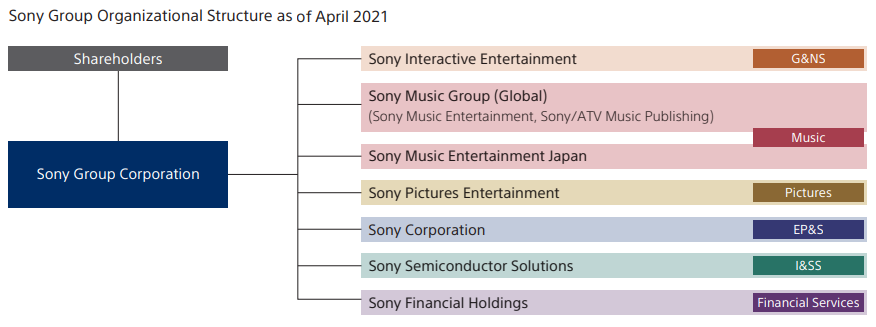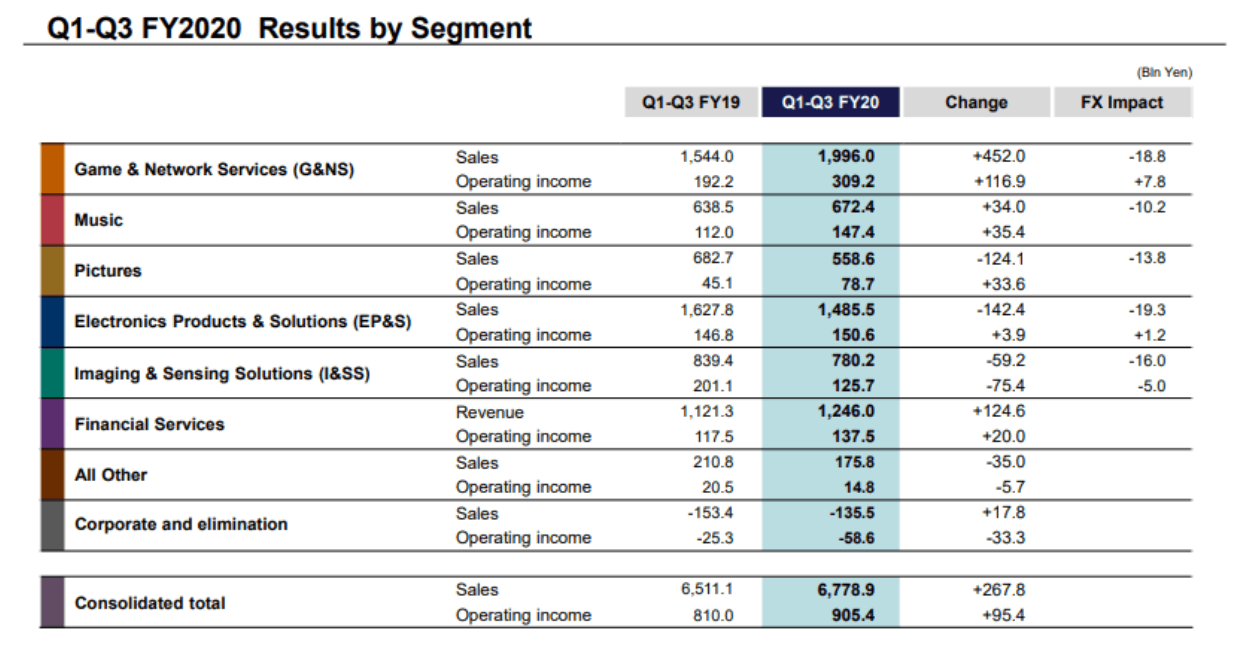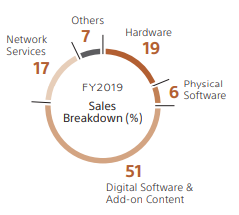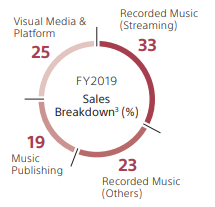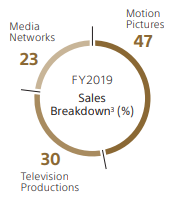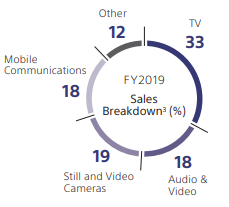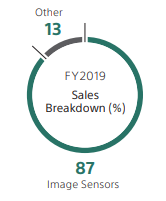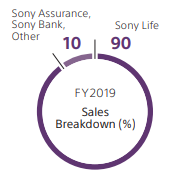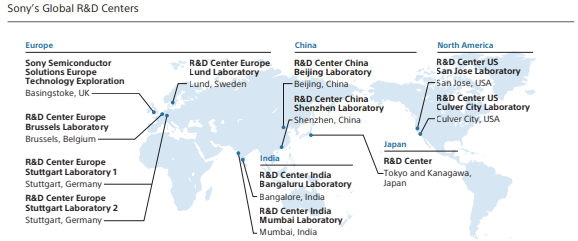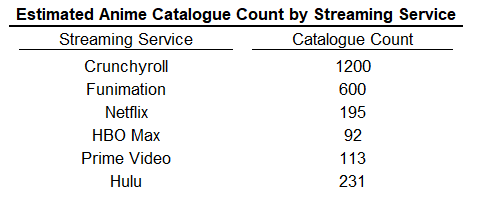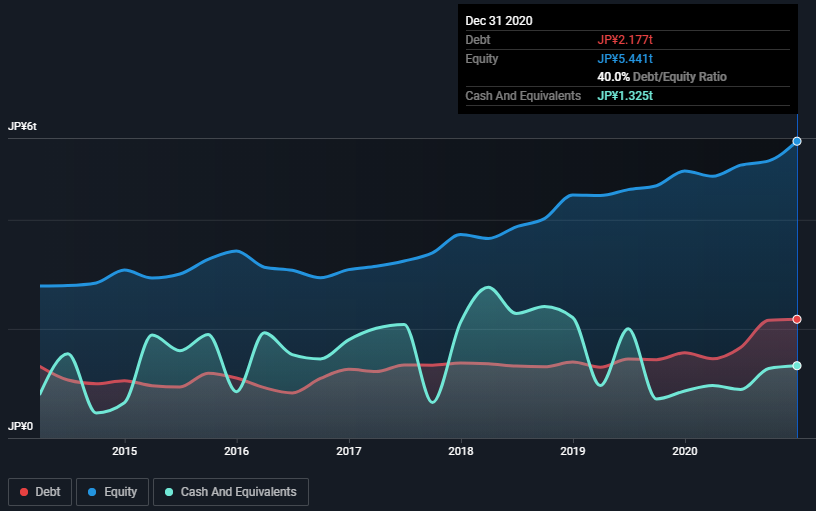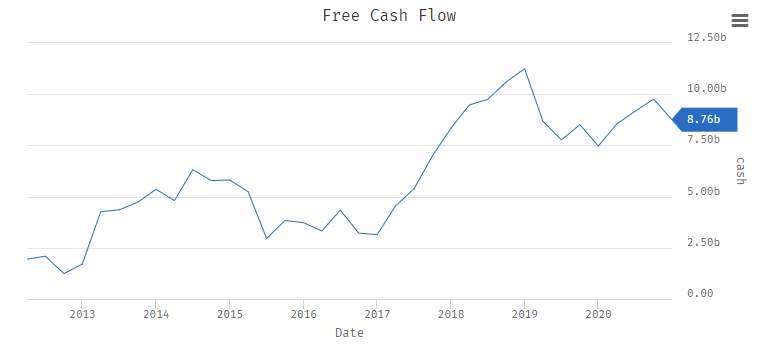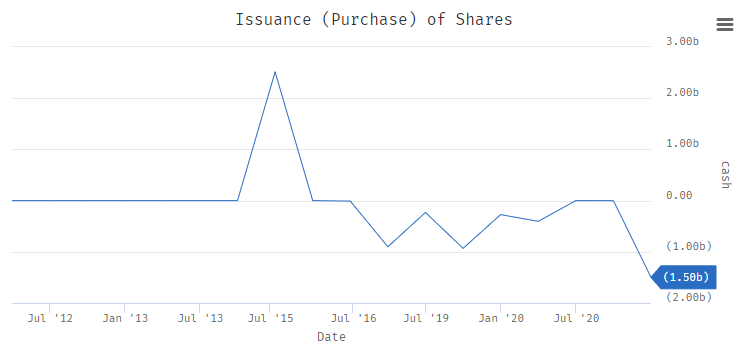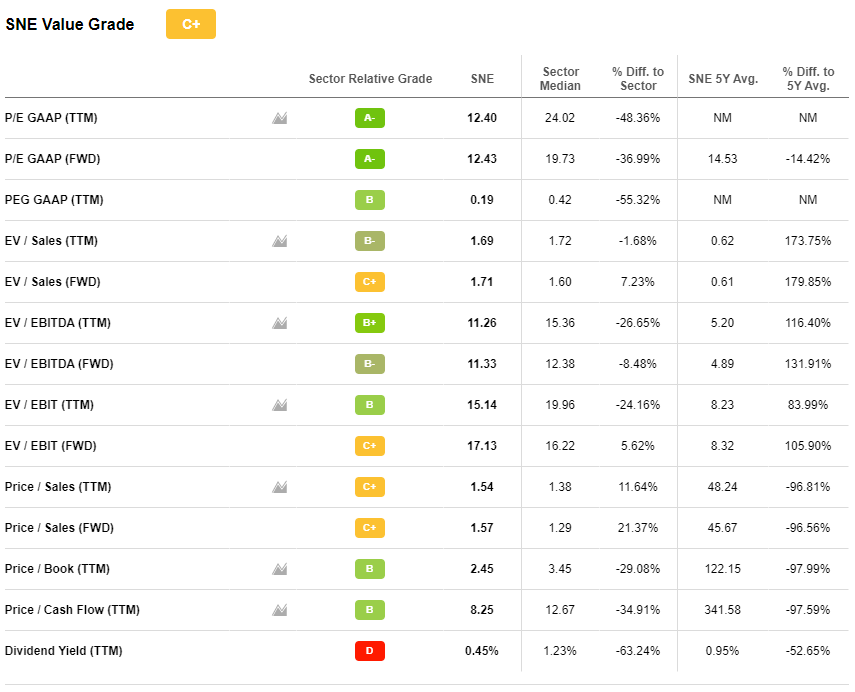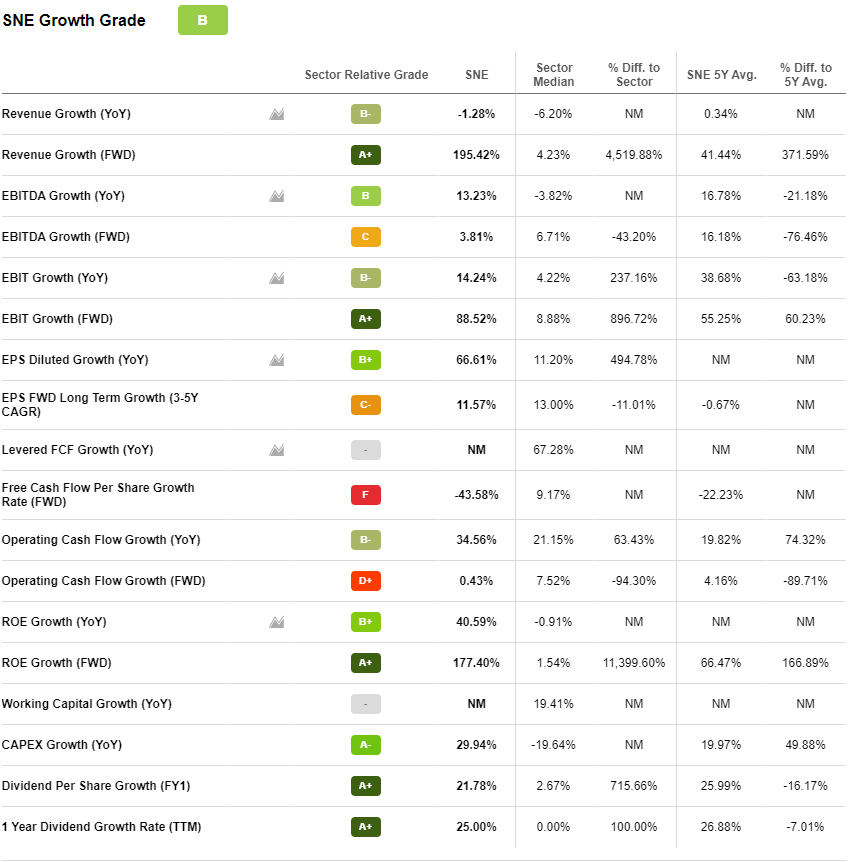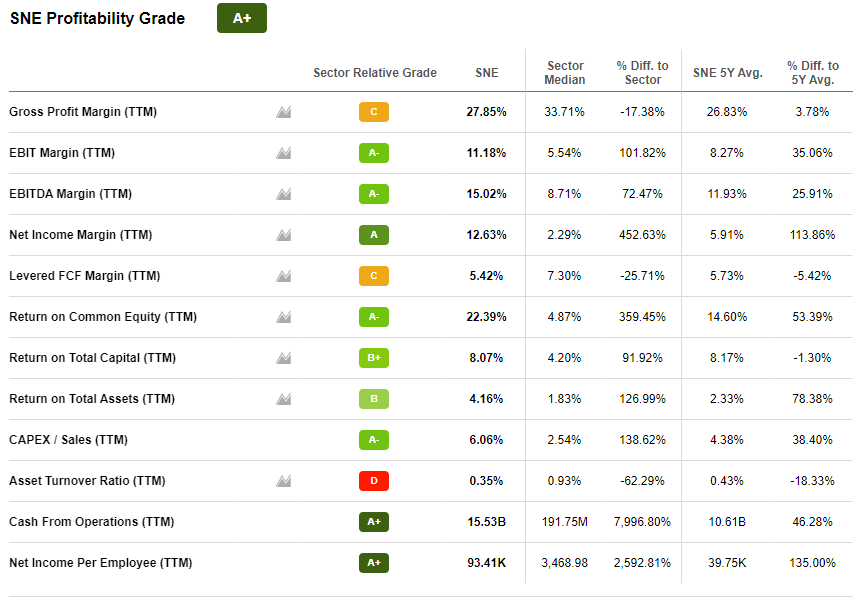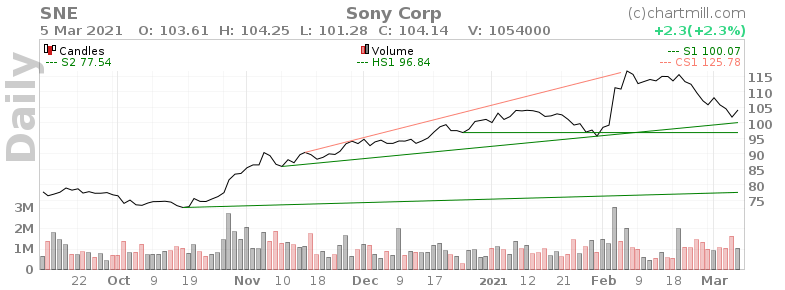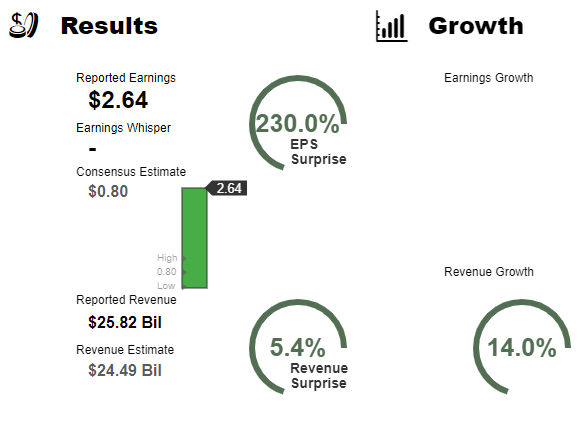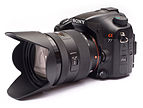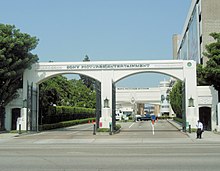Sony Corporation, «Со́ни» — японская транснациональная корпорация со штаб-квартирой в Токио, образованная 7 мая 1946 года. Специализируется на выпуске домашней и профессиональной электроники, игровых консолей и другой высокотехнологичной продукции.
Корпорация Sony была основана Акио Моритой и Масару Ибукой 7 мая 1946 года. Морита возглавлял компанию долгое время, отвечал за маркетинг и продажи и сумел привести её к огромному успеху на рынке. Sony сделала своё имя на хорошем и привлекательном дизайне и новшествах. Особенную роль компания уделяла уменьшению размеров своих изделий. В 1950 году компания, тогда ещё называвшаяся TTK, начала выпуск первого в Японии магнитофона.
Узнать больше:
ru.wikipedia.org
<div class=»text-center» style=»margin: 0 25px 5px»>
<img src=»https://cdn.quizzclub.com/social/was-it-interesting.png» alt=»Was it interesting?»>
</div>
From Wikipedia, the free encyclopedia
The following provides a partial list of products manufactured under the Sony brand.
Electronics[edit]
|
This section needs expansion. You can help by adding to it. (May 2022) |
Televisions & Home Cinema[edit]
- Televisions
- Home theater and Sound bars
- Blu-ray disc & DVD players
Audio[edit]
- Car audio
- Receivers & players
- Amplifiers
- Speakers and subwoofers
- Sony Marine
- Headphones
- MP3 players
- Walkman
- High-resolution audio
- Wireless speakers
- 360 reality audio
- Speakers
- Audio systems
- Audio components
- Digital voice recorders
- Boomboxes, radios and portable CD players
- Home cinema
Cameras[edit]
- Interchangeable-lens Cameras
- Lenses
- Compact cameras
- Camcorders
- Action cameras
- Professional video cameras
- Cinema line cameras
Mobile phones[edit]
Storage and cables[edit]
- Memory cards
- SSD disks
- Cables
Sony Olympus Medical Solutions[edit]
Sony Olympus Medical Solutions Inc. was founded on April 16, 2013, as a cooperation between Sony (owns 51%) and Olympus (owns 49%) with a goal to develop, design and sell surgical endoscopes with 4K+ resolution and 3D technologies.[1]
Sony professional[edit]
Sony Professional offers professional solutions for cinematography, filmmaking, news production, live production, education, corporate and healthcare needs.[2]
- Professional cameras
- Studio and Broadcast Cameras
- Digital Cinema Cameras
- Camcorders
- PTZ and Remote Cameras
- Broadcast and production
- Professional Monitors
- Decks and Recorders
- Switchers and Live Systems
- Professional Media
- Projectors
- Professional Projectors
- Home Cinema Projectors
- Professional displays
- Displays
- LED Walls
- Software
- Archiving and content management
- Optical Disc Archiving
- Media Asset Management
- IT Storage Media
- Digitisation and Consolidation
- Medical imaging
- Imaging Cameras
- Monitors
- Recorders and Storage
- IP Imaging Platform
- Printers and Print Media
- Audio systems
- Professional Audio
- Microphone Array System
- Professional Speakers
- Smart systems
- Workplace Management
Semiconductors[edit]
|
This section needs expansion. You can help by adding to it. (May 2022) |
Sony semiconductor business began in 1954. Today’s division Sony Semiconductor Solutions Group was founded in 2015 and focuses on manufacturing image sensors,[3] microdisplays,[4] LSI,[5] laser diodes.[6][7][8]
Image sensors[edit]
Sony produces image sensors for automotive, industry, security, consumer cameras and mobile phones.[3]
Image sensors for automotive industry[9]
Image sensors for industry[10]
- Area image sensor — industrial applications (Global Shutter and Rolling Shutter models)
- Polarization image sensor — capture polarization image with on-chip polarizer
- UV image sensor — capture images in Ultraviolet spectrum
- SWIR image sensor — capture images in Short-Wave infrared light spectrum
- ToF image sensor — creates 3D images by measuring the distance to the object
- Event-based vision sensor — event-based technology acquires high-speed data by only detecting luminance changes
Image sensors for security cameras[11]
Image sensors for consumer cameras[12]
Image sensors mobile devices[13]
Large-scale integration (LSI)[14][edit]
- GPS/GNSS Receiver
- Cellular IoT Modem (External Link)
- Gigabit Video Interface
- Audio Codec IC
SPRESENSE[edit]
A low-power board computer for the IoT.[15]
Telecommunications equipment[edit]
|
This section needs expansion. You can help by adding to it. (May 2022) |
Sony Network Communications[edit]
Sony Network Communications Inc. was founded in November 1995.[16]
Entertainment[edit]
|
This section needs expansion. You can help by adding to it. (May 2022) |
TV shows, Films[edit]
Music[edit]
Video games[edit]
Other[edit]
- Sony Computer Science Laboratories, Inc.[17]
- Sony AI Inc.[18]
- Sony VISION-S[19]
- Sony Airpeak[20]
- Sony Financial Group[21]
- Small Optical Link for International Space Station (SOLISS)[22]
References[edit]
- ^ «Corporate Information». www.sony-olympus-medical.com. Retrieved 2022-05-14.
- ^ «Sony Professional — Products and Solutions To Redefine Your Business». pro.sony. Retrieved 2022-05-14.
- ^ a b «Image Sensor:Security/Surveillance|Products|Sony Semiconductor Solutions Group». Sony Semiconductor Solutions Group. Retrieved 2022-05-14.
- ^ «Microdisplay:Microdisplay|Products|Sony Semiconductor Solutions Group». Sony Semiconductor Solutions Group. Retrieved 2022-05-14.
- ^ «LSI: Products|Sony Semiconductor Solutions Group». Sony Semiconductor Solutions Group. Retrieved 2022-05-14.
- ^ «Laser Diode|Products|Sony Semiconductor Solutions Group». Sony Semiconductor Solutions Group. Retrieved 2022-05-14.
- ^ «Corporate Information|Sony Semiconductor Solutions Group». Sony Semiconductor Solutions Group. Retrieved 2022-05-14.
- ^ «History of Sony’s Semiconductors|Corporate Information|Sony Semiconductor Solutions Group». Sony Semiconductor Solutions Group. Retrieved 2022-05-14.
- ^ «Image Sensor:Automotive|Products|Sony Semiconductor Solutions Group». Sony Semiconductor Solutions Group. Retrieved 2022-05-14.
- ^ «Image Sensor:Industry|Products|Sony Semiconductor Solutions Group». Sony Semiconductor Solutions Group. Retrieved 2022-05-14.
- ^ «Image Sensor:Security|Products|Sony Semiconductor Solutions Group». Sony Semiconductor Solutions Group. Retrieved 2022-05-14.
- ^ «Image Sensor:Consumer Camera|Products|Sony Semiconductor Solutions Group». Sony Semiconductor Solutions Group. Retrieved 2022-05-14.
- ^ «Image Sensor:Mobile|Products|Sony Semiconductor Solutions Group». Sony Semiconductor Solutions Group. Retrieved 2022-05-14.
- ^ «LSI:GPS/GNSS Receiver|Products|Sony Semiconductor Solutions Group». Sony Semiconductor Solutions Group. Retrieved 2022-05-14.
- ^ «Smart Sensing Processor Board|Products|Sony Semiconductor Solutions Group». Sony Semiconductor Solutions Group. Retrieved 2022-05-14.
- ^ Corporation, So-net. «History | Sony Network Communications Inc». www.sonynetwork.co.jp. Retrieved 2022-05-14.
- ^ «AI × Robotics». AI × Robotics. Retrieved 2022-05-14.
- ^ «About – Sony AI». Sony AI – Unleash Human Imagination and Creativity with AI. Retrieved 2022-05-14.
- ^ «Sony Group Portal — VISION-S». www.sony.com. Retrieved 2022-05-14.
- ^ «Sony Group Portal | Airpeak». electronics.sony.com. Retrieved 2022-05-14.
- ^ «Sony Financial Group». www.sonyfg.co.jp. Retrieved 2022-05-14.
- ^ «小型光通信実験装置「SOLISS」が宇宙と地上間の双方向光通信に成功 ~国際宇宙ステーションからEthernet経由で光地上局が高精細度画像を受信~ — Sony Computer Science Laboratories, Inc». Sony Computer Science Laboratories, Inc. — SONY CSL公式サイトです (in Japanese). 2020-04-23. Retrieved 2022-05-14.
External links[edit]
- Sony businesses & products
Третья по величине японская электронная корпорация после Hitachi и Panasonic. Специализируется на выпуске домашней и профессиональной электроники, игровых приставок и другой высокотехнологичной продукции. Sony является одним из крупнейших в мире медиаконгломератов — владея звукозаписывающими марками Sony Music Entertainment и EMI, киностудиями Columbia Pictures и TriStar Pictures, а также полным архивом фильмов компании MGM (совместно с компанией Comcast), оказывает финансовые услуги.
В перечень продукции компании входит аудио- и видеооборудование, телевизоры, дисплеи, полупроводники, электронные компоненты, игровые приставки, компьютеры и компьютерная периферия, а также телекоммуникационное оборудование. Sony активно занимается производством, приобретением и распространением кинофильмов и телевизионных программ, а также эксплуатацией телевизионных и цифровых сетей.
Компания присутствует на музыкальных и image-based software рынках по всему миру.
Sony управляет несколькими предприятиями, предоставляющими финансовые услуги, включая банковские операции, а также операции по страхованию жизни и страхованию, не связанному со страхованием жизни, которые управляются ее японскими дочерними компаниями.
Финансовая группа Sony в основном занимается разработкой продуктов и услуг, включающих в себя технологии, позволяющие эффективно реагировать на социальные и экономические изменения во всех сферах ее деятельности. В частности, Sony Bank предлагает потребителям ипотечные кредиты и депозиты в иностранной валюте с помощью онлайн-сервисов. Кроме того, у компании есть рекламное агентство и бизнес по обслуживанию сетей в Японии.
Она сотрудничает с Управлением Верховного комиссара Организации Объединенных Наций по делам беженцев (UNOPS).
Ранее компания была известна под названием Tokyo Tsushin Kogyo Kabushiki Kaisha, а в январе 1958 года сменила свое название на Sony Corporation.
Компания была основана в 1946 году, штаб-квартира в Токио, Япония.
Слово «Сони» произошло от объединения двух слов: «sonus» — в переводе с латыни означающее «звук» (оно входит в состав таких известных слов, как «sound» и «sonic»), и «sonny», означающее «маленький сын»). Имя SONY, по своей сути, должно было отразить энергичный, новаторский и творческий характер корпорации.
Сайт — www.sony.net
Как зарабатывает
Главные операционные сегменты Sony Corporation:
Game & Network Services (игры и сетевые услуги) — разработка и производство игровых приставок PlayStation и видеоигр, а также представление связанных с ними сетевых услуг через дочернюю компанию Sony Interactive Entertainment LLC
Home Entertainment & Sound (техника для дома) — производство телевизоров и другой аудио- и видеоаппаратуры
Sony Mobile Communications — производство мобильных телефонов (под торговой маркой Sony Xperia), планируется дальнейшее сокращение производства.
Sony Financial Holdings — операции в финансовой сфере — страхование (Sony Life), банк Sony Bank
Pictures (фильмы) — основу сегмента составляет дочерняя компания Sony Pictures Entertainment, которая занимается производством и продюсированием кинокартин, владеет киностудиями Columbia Pictures и TriStars Pictures, а также полным архивом фильмов компании MGM (совместно с компанией Comcast), также в этот сегмент входит производство и распространение телевизионных фильмов и программ, кроме того Sony принадлежит телевизионная сеть в Индии и кабельная сеть в США
Semiconductors (полупроводники) — производство полупроводниковых компонентов, гальванических элементов, оптических головок, карт памяти и так далее
Imaging Products & Solutions (фото- и видеотехника) — производство цифровых фотоаппаратов и видеокамер
Music (музыка) — деятельность звукозаписывающих компаний Sony Music Entertainment, Sony/ATV Music Publishing LLC и EMI
В настоящее время, после недавней реорганизации, компания отчитывается по шести сегментам:
Game & Network Services — 33% от общей выручки
Music — 9,9%
Pictures — 7,1%
Electronics Products & Solutions — 24,2%
Imaging & Sensing Solutions (ранее Semiconductors (полупроводники) — 9,9%
Financial Services — 15,9%
Географически распределение выручки корпорации в 2016 (это самое свежее из найденого) году выглядело следующим образом:
Япония — 29,9%
США — 22,9%
Европа — 21,5%
Китай — 8,9%
Азиатско-тихоокеанский регион — 10,5%
другие регионы — 6,3%
На собственных производственных мощностях производится 64 % продукции. Почти половина продукции изготавливается на предприятиях в Японии. Также есть крупные заводы в США (Индиана), Китае (Хойчжоу, Пекин, Уси), Малайзии (Пинанг и Банги), Таиланде, но за рубежом преобладает производство сторонними подрядчиками, на них приходится 57 % произведённого в КНР и 72% произведённого в других странах Азии, в то время как в Японии корпорация почти полностью полагается на собственное производство, на него приходится 89%
В июле 2011 года Sony DADC купила завод по производству оптических CD, DVD, Blu-Ray дисков в городе Боровске (Калужская область)
Основные регионы деятельности — Япония, США, Китай и страны Европы.
Около четверти выручки Sony приходится на Playstation и игры. Еще около четверти — на производство электроники. Остальное — примерно поровну поделено между бизнесом сенсоров, киноиндустрией, музыкой и финансовыми сервисами.
Рекомендую к ознакомлению — https://www.sony.net/SonyInfo/IR/library/corporatereport/CorporateReport2020_E.pdf
🎐Аргументы в пользу компании
— Sony занимает 7-е место в списке 15 крупнейших мировых производителей технологического оборудования.
— Сегмент игровых и сетевых услуг извлекает выгоду из роста продаж игрового программного обеспечения и подписки на PlayStation Plus. Компания выпустила игровую консоль нового поколения — PlayStation 5 (PS5). Благодаря мощному 8-ядерному процессору AMD Zen 2, графической мощи 10,3 терафлопс, великолепному изображению 4K, PS5 обещает достичь наивысшей производительности, когда-либо демонстрируемой в игровых консолях. Продажи приставки велики и продолжают расти. За все время существования рынка игровых консолей Sony остается бесспорным лидером сегмента домашних (не портативных) приставок. Компания произвела и поставила свыше 500 млн устройств против 150 млн у Microsoft. Несмотря на проблемы с поставками, компания планирует реализовать 7,6 миллиона консолей к концу марта 2021 года. Компания также ожидает, что к концу следующего финансового года эта цифра достигнет 14,8 миллиона единиц или больше. Sony столкнулась с высоким спросом, ситуация осложняется проблемами на производстве из-за дефицита комплектующих. Финансовый директор компании добавил, что Sony «делает всё возможное, чтобы отгрузить как можно больше единиц в кратчайшие сроки».
— Sony очень хорошо понимает, что «контент — это король». Компания работала со своими партнерами над созданием высококачественных игр, большинство из которых являются эксклюзивными для PlayStation. Кроме того, Sony приняла стратегии объединения продуктов, чтобы использовать качественный контент для увеличения продаж своих консолей. Объединение продуктов является очень важной тактикой продаж, чтобы соблазнить геймеров купить консоль, чтобы они могли играть в самые ожидаемые игры
— Sony повысила прогнозируемые финансовые результаты на финансовый год, заканчивающийся 31 марта 2021 года. Японский технологический гигант ожидает, что операционная прибыль составит около 8,9 миллиардов долларов по итогам всего финансового года, который закончится 31 марта 2021 года.
— Аниме это целый пласт со своей культурой. В декабре Sony купила сервис потоковой передачи аниме Crunchyroll у AT&T за ~ 1,2 млрд долларов, что означает, что Sony теперь является монополистом среди основных платформ потокового аниме, владея Funimation и Crunchyroll. Аналитики предполагают, что в мире насчитывается 140 миллионов фанатов аниме, описанных ими самими, а Sony владеет двумя самыми популярными в мире потоковыми платформами. В июле 2020 года Crunchyroll имел 3 миллиона премиальных (платящих членов) и 70 миллионов участников. Теперь задача Sony — доказать клиентам, что их платные услуги лучше, чем бесплатные (кража через торренты и т. д.) ожидается, что размер мирового рынка аниме достигнет среднегодового темпа роста 9,1%, опережая темпы роста фильмов и развлечений на 4,1%.
— Sony укрепляет свои бизнес-сегменты за счет приобретения новых компаний и создания совместных предприятий. Sony Semiconductor Solutions в сотрудничестве с Microsoft создала решения, которые упрощают доступ к интеллектуальным камерам на базе AI и видеоаналитике для их общих клиентов.
— Sony ожидает, что сегмент «Music» выиграет от высоких доходов от потоковой передачи данных, высокой эффективности мобильного игрового приложения «Fate/Grand Order» и эффекта от консолидации EMI Music Publishing.
— В последние годы компания Sony добилась роста продаж в сегментах Imaging & Sensing Solutions (ранее Semiconductors) и Music. Она повысила рентабельность в сегменте Electronics Products & Solutions и обеспечила стабильный рост прибыли в сегменте Financial Services. В будущем компания ожидает роста спроса на image sensors для мобильных устройств, что, в свою очередь, будет стимулировать продажи Semiconductors.
— Sony концентрируется на премиальном сегменте рынка брендовых продуктов для максимального роста. Она создала 360 Reality Audio, чтобы слушатели чувствовали себя погруженными в звук со всех сторон. Это было реализовано с помощью объектно-пространственной аудиотехнологии компании. Компания работает с крупными музыкальными брендами, предоставляющими услуги по распространению музыки, чтобы обеспечить распространение технологии и создания комюнити вокруг музыкальной экосистемы 360 Reality Audio. Sony также работает над распространением этого музыкального сервиса среди создателей музыки, художников и любителей музыки с целью создания совершенно нового мира музыкальных развлечений.
— Sony уже разрабатывает информационно-развлекательные системы для автомобилей, производит автомобильные сенсоры, является лидером в области визуализации CMOS и LIDAR и т.д. Автомобильная пресса заметила, когда Sony представила этот продукт, что система Vision-S от Sony выглядит так же футуристично и современно, как и продукция Tesla. Автомобиль оснащен современными дисплеями с высоким разрешением и чистым UI, 33 автомобильными датчиками, обеспечивающими полуавтономное вождение и современной эстетикой. Sony была достаточно молчалива по поводу этого автомобиля, в 2020 году обзывала его концепцией, а теперь объявила о том, что в этом году они публично тестировали его на дорогах и сотрудничали с Magna в области разработки. Похоже, что Sony работает над моделью, похожей на модель Fisker
— Sony уже имеет опыт разработки электронных систем для автомобилей и является одним из ведущих разработчиков LIDAR в мире, сенсорная технология которого используется в разработке автономных автомобилей. Sony LIDAR уже присутствует на высококлассных флагманских моделях iPhone, iPad, Samsung и Huawei. Sony утверждает, что Vision-S уже имеет 2-й уровень автономности, разработанной собственными силами, а также оснащена информационно-развлекательными и электронными технологиями, разработанными компанией Sony. Нетрудно представить себе мир, в котором Magna создает оболочку и аккумуляторный блок для Sony, способный вместить в себя сенсоры Sony и технологии салона. Vision-S все еще находится на ранних стадиях разработки, но Sony была бы очень ценным партнером Magna по поставкам сенсоров и электронных систем, и возможно есть партнерство с такими традиционными японскими автопроизводителями, как Toyota. Традиционный опыт автопроизводителя в области производственных линий и производства в сочетании с возможностями Sony в области электроники сделал бы идеальную пару.
— Хорошие отзывы как о работодателе
— Неплохое финансовое здоровье
— 12 января 2021 года компания Sony представила летательный аппарат «Airpeak» в рамках проекта беспилотного летательного аппарата в области автоматизированной робототехники. Компания запустила бренд Airpeak для дальнейшего развития технологии беспилотных летательных аппаратов. Весной 2021 года Sony запустит новый бизнес, нацеленный на профессиональное фото- и видеопроизводство. Полезная нагрузка беспилотника может быть оборудована беззеркальной камерой Alpha для съемки высококачественной полнокадровой аэрофотосъемки и видео. Этот инновационный продукт внесет свой вклад в мир развлечений, одновременно стремясь к новым возможностям для творчества. Беспилотные летательные аппараты, скорее всего, улучшат эффективность работы в различных отраслях промышленности при соблюдении самых высоких стандартов безопасности и надежности. Разработка отражает ориентацию компании Sony на технологии 3R (реальность, реальное время и дистанционное управление) в области беспилотных летательных аппаратов. Посредством этой инициативы компания стремится внести свой вклад в эволюцию беспилотных летательных аппаратов и получить прибыль на этом растущем рынке.
— Сильный денежный поток.
— Платит дивиденды, хотя и низкие — около 0,5% годовых. На них уходит менее 10% прибыли.
— Также проводит байбеки, в 2019 выкупили 2% капитализации.
— Невысокий P/E
— Высокий рейтинг аналитиков.
— Sony подписала многолетнее соглашение с Lions Gate Entertainment Corp о дистрибьюторской деятельности в США и Канаде. Lions Gate будет по-прежнему осуществлять независимые продажи и маркетинг, используя при этом каналы поставок и дистрибьюторские услуги Sony Pictures. «Сотрудничая друг с другом, мы сможем определить и использовать эффективность цепи поставок, которая принесет пользу не только нашим соответствующим студиям, но и розничным продавцам, и, в конечном счете, миллионам потребителей, которым нравятся художественные фильмы и телевизионные программы Sony Pictures и Lionsgate в форматах 4K UHD, Blu-ray и DVD», — заявил исполнительный вице-президент Sony Pictures
— Sony была пионером в индустрии консолей в отношении облачных игровых сервисов, запустив свой облачный игровой сервис PlayStation Now в 2014 году. У PS Plus более 100 миллионов подписчиков, которые платят 60 долларов в год. 87% игроков PS5 получают подписку PS Plus. PS Now имеет> 2,2 млн подписчиков, опережая Google Stadia, предлагающих контент Sony игрокам на ПК. По состоянию на конец апреля 2020 года, а общее количество пользователей PlayStation Now увеличилось примерно в 2,5 раза после того, как было представлено мобильное приложение PS Remote Play. Как сообщается на сайте Sony PlayStation, геймеры могут использовать мобильное приложение PS Remote Play для удаленной игры PlayStation 5 и PlayStation 4 на своих смартфонах при условии, что их смартфоны подключены к высокоскоростной сети Wi-Fi.
— Взгляд Sony на динамику развития бизнеса в различных сегментах рынка в 2021 финансовом году и в последующий период
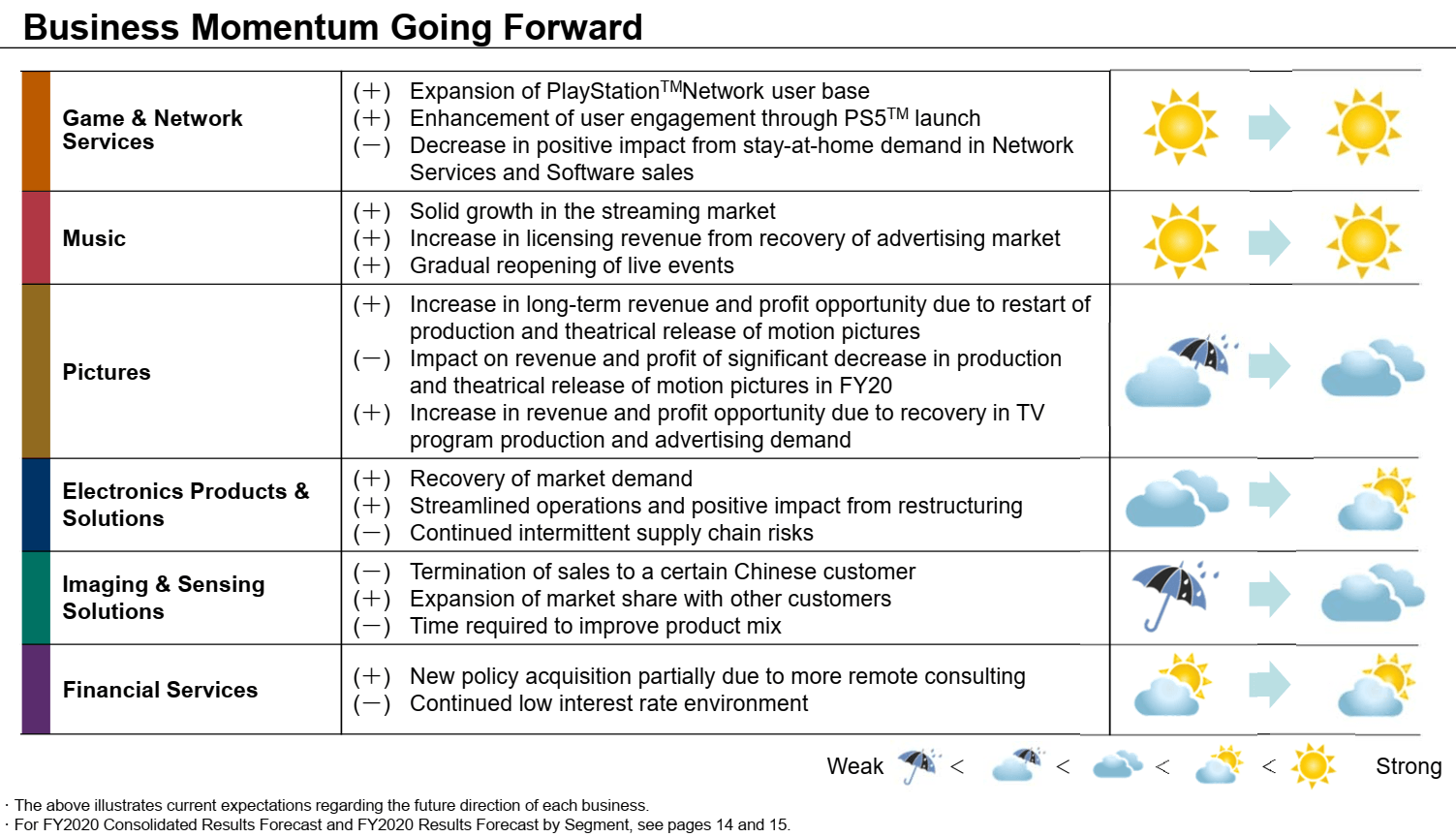
— Из-за коронавируса и закрытых кинотеатров страдает сегмент кино (Sony Pictures). В третьем квартале 2020 финансового года продажи в сегменте «Pictures» упали на 19% в годовом исчислении и составили 191,1 млрд. йен. Снижение было вызвано существенным уменьшением доходов от проката из-за закрытия кинотеатров в связи с пандемией COVID 19, снижением доходов от рекламы для медиа-сетей и падением доходов из-за сокращения объемов выпуска сериалов в связи с остановкой производства. Продажи в сегменте Imaging & Sensing Solutions снизились на 10,4% в годовом исчислении и составили 266,9 млрд. иен из-за снижения продаж матриц изображений для цифровых камер.
— Не забываем, что компания расположена в Японии, а значит это периодические природные катаклизмы, поэтому, оборудование и информационные системы компании Sony подвержены повреждениям, вызванным катастрофами, перебоями в работе, злонамеренными действиями или кибератаками. Компания столкнулась с несколькими кибератаками, что привело к росту недовольства клиентов за последние годы. Руководство компании заметило, что к хищениям были причастны некоторые бывшие руководители и сотрудники Sony Field Company. После предварительной оценки руководство подсчитало, что в результате этого противоправного поведения был нанесен ущерб в размере 900 млн. иен.
— Sony сталкивается с жесткой конкуренцией в каждой из своих линеек продукции, включая телевизоры, игровые платформы и смартфоны, по всему миру. Если не создавать новые продукты, которые бы соответствовали потребительскому спросу, это может привести к снижению продаж продукции компании. На каждом из этих рынков ведутся жесткие ценовые войны, постоянно внедряются инновационные продукты и меняются предпочтения покупателей, что оказывает давление на компанию Sony, требуя от нее выпускать более качественную продукцию для сохранения конкурентоспособности. Несмотря на то, что инициативы компании Sony по реструктуризации бизнеса прокладывают путь к повышению рентабельности и акционерной стоимости в долгосрочной перспективе, в ближайшей перспективе это увеличивает расходы на реструктуризацию. Следовательно, компания должна проявлять осторожность, так как эти расходы, в случае их значительного увеличения, могут отразиться на ее финансовом положении.
Сравнение с некоторыми конкурентами — https://yadi.sk/d/kfXHrwNB4kdLjg
— Sony — конгломерат состоящий из разных бизнесов. Это усложняет аналитикам прогнозирование компании.
— Sony продает каждую PlayStation 5, которую она производит, в убыток, чтобы увеличить свою долю рынка, это называется дэмпинг, но с другой стороны это не лишено смысла на горизонте от 3 лет. Майкрософт, кстати, делает примерно также. Microsoft и Tencent — главные конкуренты Sony в игровом бизнесе.
— Программа Vision S все еще находится на начальной стадии, и, хотя она может быть благом для Sony, разработка автомобиля может быть чрезвычайно дорогостоящей (подумайте, как минимум 1 миллиард долларов для разработки нового автомобиля). У потенциальных конкурентов Sony в области электромобилей, таких как Tesla и Nio, есть инвесторы другого типа, которые не ориентированы на среднесрочную прибыль, и вопрос, допустят ли акционеры Sony значительные операционные убытки, чтобы создать жизнеспособного конкурента Tesla и Nio. Руководство Sony, вероятно, также не заинтересовано в привлечении капитала на публичных рынках (вместо этого они выкупали акции). Этот риск ограничен тем фактом, что Sony, судя по всему, придерживается модели «без активов», работая с Magna.
— LIDAR — одна из многих конкурирующих технологий, обеспечивающих автономное вождение. Хотя большинство автопроизводителей используют LIDAR, Tesla отказалась от этого. Драйвер роста Sony в этом бизнесе не обязательно будет плодотворным.
— американские инвесторы обычно не понимают японские компании, также как и китайские, а американцы могли бы помочь финансово.
🎐Фундаментальные показатели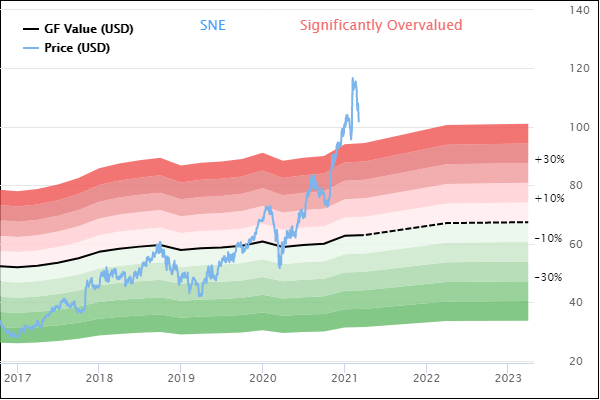
Зона поддержки от 103,23 до 103,39
Поддержка на уровне 100,07
Зона поддержки от 95,71 до 96,84
Поддержка на уровне 85,74
Поддержка на уровне 77,54
Зона сопротивления от 116,71 до 116,71
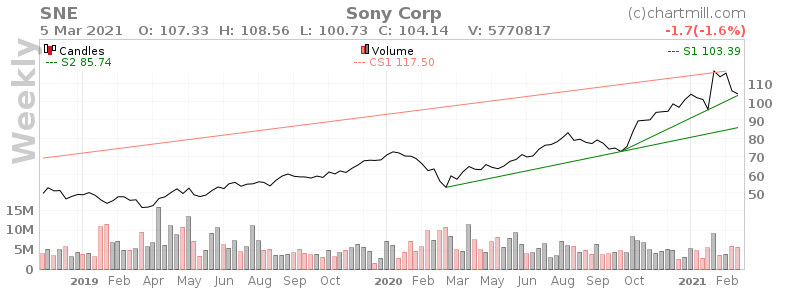
✔ Zacks Rank: 1-Strong Buy
✔ Сводный прогноз Reuters: 4.13 (Buy) — Прогнозная цена Reuters: 13034.74 JPY
✔ Wall St. Analysts Rating Bullish — PRICE TARGET $134.06
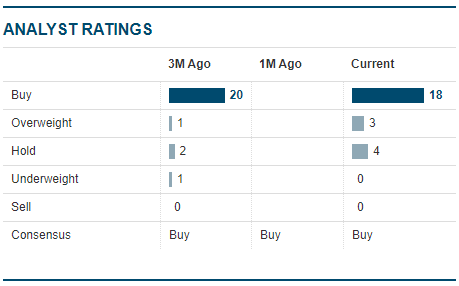
Корпоративный отчет 2020
Earnings Call Transcript
Компания Sony (SNE) сообщила о прибыли за 3-й квартал в размере 2,64 долл. на акцию при выручке в 25,8 млрд. долл. Консенсусная оценка прибыли составила $0,80 на акцию при выручке $24,5 млрд. Выручка выросла на 14,0% в годовом исчислении.
Следующий отчет ожидается 5 мая
🎐Инсайдерские сделки
Инсайдерские сделки не найдены.
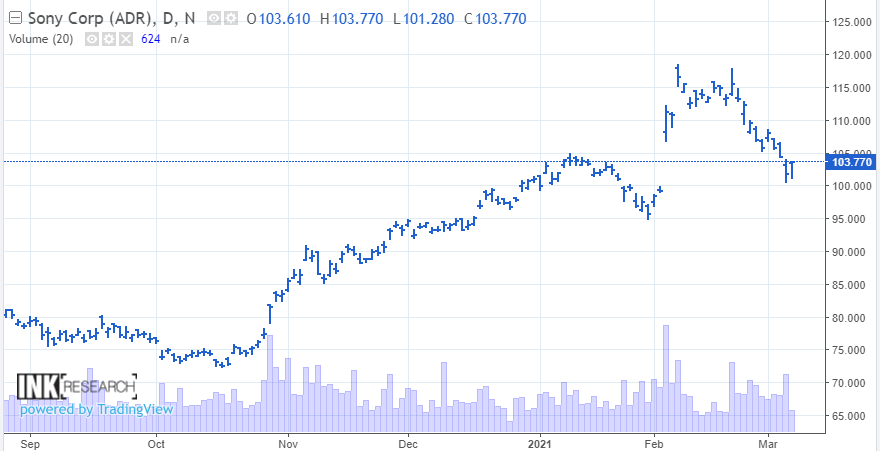
Institutions — 51.75%
Corporations (Public) — 0.05%
Individuals / Insiders — 0.03%
State Owned Shares — 1.55%
Public and Other — 46.63%
Тренд: ▼ Хедж-фонды уменьшили объем владения на 2,3 млн. акций в прошлом квартале.

Помню как Sony в 2010-2015 годах была не очень… что теперь?
Sony, похоже, переживает возрождение бытовой электроники, даже не считая PlayStation. Телевизоры, наушники и камеры Sony снова являются лучшими в своем классе, и Sony может запрашивать повышенную цену на свои товары, потому что качество возвращается. У меня у самого лично, дома есть некоторое количество техники от Sony — телевизор (но сам телевизор в традиционном ключе я уже очень давно не использую), домашний кинотеатр, аудиоколонка, наушники sony wh-1000xm4 и я вам должен сказать это очень хорошие наушники и когда-то у меня были телефоны от Sony.
Немного жалею только об одном, что акции компании не купил осенью по 70, хотя очень хотелось, но не было на это бюджета.
Теперь надеюсь урвать по 95-100 или ниже и держать, Sony весьма неплохо развивается последние годы.
Вакцины распространяются, съемки кино должны восстановиться, а изголодавшиеся зрители по новинкам наверняка будут ждать новых фильмов. 2021 должен стать неплохим годом для Sony Pictures.
Sony никогда не собиралась становиться разработчиком игровых консолей. PlayStation появилась как счастливый случай. Sony просто начала поставлять компакт-диски (CD) для Nintendo и в конце концов выпустила Nintendo 64 с картриджем. Sony поняла, что у них есть конкурентное преимущество в разработке игрового оборудования. Sony сделала большинство компонентов, которые уходили в «чужую» игровую консоль, имели очень глубокие финансовые карманы и видели брешь на рынке. Так появилась на свет система PlayStation. Жесткий контроль Sony над аппаратным обеспечением, возможность разрабатывать многие компоненты для Sega и Nintendo на протяжении десятилетий удерживали платформы Sony на техническом превосходстве над конкурентами и сделали компанию Sony крупнейшим производителем игровых консолей в мире. Microsoft и Tencent — главные конкуренты Sony в игровом бизнесе, но что мешает их всех добавить себе в портфель, я там и сделал)
Выпуск и продажи PS5 с эксклюзивными играми в придачу, может принести солидную прибыль долгосрочным акционерам, если цифры превзойдут ожидания аналитиков. У Sony есть несколько фильмов, которые должны быть выпущены в течение 2021 года и все это может быть драйвером, который еще не учтен в цене акций, что дает инвесторам дополнительный потенциал роста, но только время и отчеты о доходах покажут, как акции SNE действительно имеют большой потенциал.
Я намерен добавить акции компании себе в портфель на средне-/долгосрочную перспективу.
Как обычно с меня информация, а все решения вы принимаете сами. Успехов!
🎐Ссылки
Bull of the Day: Sony
SNE или SONO: какая акция сейчас лучше?
🔔 Дисклеймер
✅ Подписывайтесь
✅ Открыть брокерский счет и получить месяц торговли без комиссии
✅ Профиль автора в Тинькофф Инвестиции
✅ Донаты
Решения принимаются инвестором самостоятельно. Информация, представленная здесь, не является индивидуальной инвестиционной рекомендацией, а упоминаемые финансовые инструменты могут не подходить вам по инвестиционным целям, допустимому риску, инвестиционному горизонту и прочим параметрам индивидуального инвестиционного профиля. При подготовке представленных материалов была использована информация из источников, которые, по мнению автора, заслуживают доверия. При этом данная информация предназначена исключительно для информационных целей, не содержит рекомендаций и является выражением частного мнения. Невзирая на осмотрительность, с которой автор отнесся к составлению этой страницы, автор не дает никаких гарантий в отношении достоверности и полноты содержащейся здесь информации. Никто ни при каких обстоятельствах не должен рассматривать эту информацию в качестве предложения о заключении договора на рынке ценных бумаг или иного юридически обязывающего действия. Автор не несет никакой ответственности за любые убытки или расходы, связанные прямо или косвенно с использованием этой информации. Данная информация, действительна на момент ее публикации, при этом автор вправе в любой момент внести в информацию любые изменения. Результаты инвестирования в прошлом не определяют доходы в будущем. Автор предупреждает, что операции с ценными бумагами связаны с различными рисками и требуют соответствующих знаний и опыта.
-
Главная
-
Общество
На выпуске какой продукции специализируется компания Sony?
Правильный ответ: Электроника
Играйте в лучшую игру-викторину
45 Comments
на этот вопрос не правильно отвечали? серьёзно?
кто-то ответил автомобили? вот же ржака
А кто то отметил что мебель😂😂😱😱
Хотела бы я посмотреть на мебель от SONY
Я бы не отказался от стройматериалов Sony.
У меня были наушники сони
Причём тут автомобили скажите пожалуйста?
Вам не всё равно кто как ответил ? Зачем Вам это нужно ? Самоутвердиться что Вы умнее кого то ?
Супер-знайка, Sony Vision-S электромобиль….


ПОЖАЛУЙ, САМАЯ КАЧЕСТВЕННАЯ ПРОДУКЦИЯ!!!

блин японцы молодцы год как проиграли войну а тут такую фирму создают)))

у моей бабушки есть телевизор такой марки

Я надеюсь, что ни для кого из вас, уважаемые игроки, не возникнет вопрос: «Почему так?» Ведь все знают, что разработки лекарств и всего остального проводились на пленниках… И фирма Байер, не помню как пишется на английском правильно. Все свои методы разрабатывала и испытывала на узниках Освенцима и других гонцлагерях, добившись мирового признания на костях невинных
Очень лёгкий вопрос. Кто ответил неправильно — ставьте дизлайк! (шутка) ☺
Юлич, и у меня тоже , пойдем играть
я ответила овтомобиль🤣🤣🤣🤣🤣🤣😭

Мебель? Серьёзно? АЖАЭАЭАЭ
Кто серьёзно не ответил на этот вопрос?


Александр, согл согл согл согл согл согл согл согл согл согл согл согл согл согл согл согл

Супер-знайка, я ответил. Чел я незнал что это такое и просто на обум нажал
кирачка, проверочное слово

Електроніка я угадала хух



пишу свои книги на Dreams под псевдонимом «Karishka»

Александр, я согласна с вами, я сама бы ответили мебель или автомобиль если бы не вспомнила что видела такой телефон. И вправду какая вам разница? Не всё знают , если знаете вы.

Большинство вопрос лёгкие,но развёрнутый ответ,эт круто

Треш, я думала и дкмала треш🤔🤔

выйдет новая машина Honda и Sony вместе…
Sony, Sony Corporation, «Со́ни» (яп. ソニー株式会社 Сони: кабусики-гайся) — японская транснациональная корпорация. Пожалуй, это самый узнаваемый и известный бренд электроники в мире.
Sony, входящая с компаниями Hitachi и Panasonic в тройку гигантов японского электронного рынка, обязана своим существованием предпринимателю Акио Морита (Akio Morita), за плечами которого стоит Университет Осаки (факультет физики), и его другу Масару Ибука (Masaru Ibuka), окончившему факультет электротехники Университета Васэда в Токио и обладающему талантом инженера-электронщика.
Приятели познакомились во время Второй мировой войны, работая в научно-исследовательском комитете ВМС (Navy’s Wartime Research Committee), который специализировался на создании нового оружия — в том числе приборов теплового наведения.
Семья Мориты владела бизнесом по производству сакэ и соевого соуса. Мать привила Акио любовь к музыке, а благодаря отцу он приобрел опыт управления фирмой. В школьные годы мальчик увлекался естественными науками — лучше всего ему давалась физика. Уже тогда он смастерил электрофонограф и свой первый радиоприемник.
История Sony началась с небольшой мастерской по ремонту радиоприемников и прочей электроники, которой владел Масару Ибука и которая располагалась в здании пострадавшего от авианалетов токийского универмага «Сирокия» (Shirokiya Department Store).
В первое время Ибуке и его соратникам приходилось изобретать и продавать в буквальном смысле все, что угодно — даже электрические рисоварки и электрогрелки. Однако упор делался на коммуникационное оборудование — приемники (переделка, добавление коротковолнового диапазона), радиостанции, измерительные приборы и прочее.
Несмотря на послевоенную разруху, Масару не отчаивался и был полон амбиций. В его планы входила организация серьезной фирмы, связанной с производством электронной аппаратуры.
Вскоре к нему присоединился Акио Морита, а 7 мая 1946 года приятели зарегистрировали компанию под названием Tokyo Tsushin Kogyo Kabushiki Kaisa (сокращенно — Totsuko, японский эквивалент названия «Tokyo Telecommunications Engineering Corporation», т.е. «Токийская телекоммуникационная инженерная корпорация»), стартовавшую с капиталом всего в 190 000 иен (в то время — чуть более 500 долларов).
Основатели тщательно изучали электронные приборы зарубежного производства и учились делать свои оригинальные вещи. Позже Ибука отмечал, что цель основания компании состояла в том, чтобы «создать идеальную фабрику, воплощающую в себе дух свободы и широту взглядов, которая благодаря применению новых технологий будет способствовать развитию японской культуры».
О серьезности подхода Ибуки к своему делу свидетельствует так называемый «Учредительный Проспект» (The Founding Prospectus), в котором он подробно изложил цели и задачи своего детища. «Однако когда мы фактически начали свою деятельность, стало понятно, насколько срочно и незаменимо Япония нуждается в такой компании, как наша — с технологическим духом и набором управленческих политик», — вспоминает Ибука.
В 1953 году, после поездки в США, Акио Морита решил изменить название Tokyo Tsushin Kogyo K.K., так как американцам с трудом давалось его произношение. В своей автобиографической книге «Сделано в Японии» Морита рассказывал об этом так: «Мы хотели, чтобы новое название легко запоминалось в любой точке земного шара, чтобы оно одинаково произносилось на любом языке. Мы испробовали не один десяток названий.
Вместе с Ибукой мы рылись в словарях в поисках звучного слова и натолкнулись на латинское слово «сонус», означающее «звук». Само это слово, казалось, было наполнено звуком. Наш бизнес был тесно связан со звуком, поэтому мы начали пробовать варианты со словом «сонус».
В то время в Японии росла популярность слов и прозвищ, позаимствованных из английского сленга. Некоторые стали называть сообразительных и оригинальных молодых парней «сонни» или «сонни-бой» (что означало в переводе с английского — «сынок»). И слово «санни» (солнечный), и слово «сонни» звучали оптимистично и радостно — как и латинский корень, с которым мы работали. В те дни мы тоже считали себя «сонни-бойз».
К сожалению, само слово «сонни» создало бы нам в Японии трудности, потому что в условиях перевода японской графики на латинскую слово «сонни» произносилось бы как «сон-ни», что означает «потерять деньги». Такое название не годилось для нового товара.
Мы некоторое время обдумывали эту проблему, и в один прекрасный день мне пришло в голову решение: почему бы просто не вычеркнуть букву и не назвать компанию «Сони»? Слово было найдено!»
Первый японский магнитофон
В 1949 году Tokyo Tsushin Kogyo K.K. представила первый опытный образец магнитофона, а годом позже — первую в Японии магнитную пленку с бумажной основой «Soni-Tape».
Вскоре на прилавках магазинов появился G-Type (Type G) — первый катушечный магнитофон в линейке компании, который, по сути, стал первым магнитофоном, выпущенным на Японском архипелаге.
Аппарат обеспечивал скорость в 19 см/с и поначалу использовался в верховном суде и прочих правительственных учреждениях, отчего получил прозвище «Type G» (буква «G» указывала на «government» — «правительство»). Суды послевоенной Японии страдали от нехватки стенографистов, а магнитофон мог полностью их заменить.
В это же время основатели Sony столкнулись с непредвиденной проблемой: потребители просто понятия не имели, что за продукт перед ними. Данный факт побудил Акио Мориту написать книгу «Магнитная магнитофонная запись — что такое магнитофон?», где он дал четкое определение магнитной записи (сравнив ее с фотографией), а также описал ее механизмы и варианты применения.
В 1951 году появился бытовой катушечный магнитофон H-1, который называли «Type H», намекая на то, что модель предназначается для домашнего пользования (home). Аппарат имел необычный дизайн, выполненный в виде «чемодана», что обеспечивало удобство его транспортировки.
Транзисторный бум
В 1954 году Sony выкупила патент на разработанные компанией Bell Laboratories транзисторные технологии у американской компании Western Electric, выступавшей в роли держателя патентов. В итоге, инженеры Sony смогли создать сплавной PNP-транзистор, который позволял сделать электронные компоненты более компактными, а еще отличался меньшим энергопотреблением по сравнению с радиолампами.
В 1955 году был выпущен первый продукт с логотипом Sony — радиоприемник TR-55, который имел на борту пять таких транзисторов. Чуть позже на прилавках появился набор TR-2K, позволяющий покупателю собственными руками собрать портативное радиоустройство с наушником.
В 1957 году компания выпустила первый в мире компактный транзисторный радиоприемник TR-63, благодаря чему в обиход прочно вошел термин «pocket-size» («карманный»).
Модель также стала первым полноценным экспортным продуктом Sony. Через год в серию пошел портативный транзисторный радиоприемник TR-610 с новым дизайном, который в итоге стал настоящим хитом по обе стороны Атлантики и был продан тиражом в 500 000 экземпляров.
В 1957 году рекламный щит Sony появился в элитном токийском районе Гиндза, а в 1958 году компания получила приставку «Corporation» и в декабре была впервые представлена на Токийской фондовой бирже. В это же время компания разработала опытный образец видеомагнитофона.
В 1959 году инженеры Sony упорно трудились над созданием первого в мире портативного транзисторного телевизора. Это была мечта Масару Ибуки, которая воплотилась в жизнь 25 декабря 1959 года. Продажи телевизора стартовали в 1960 году.
Модель имела 8-дюймовый экран и называлась TV8-301. Американские маркетологи, посетившие Sony, предрекали транзисторному мини-ТВ провал, так как в то время в США было принято планировать выпуск новых продуктов на основе рыночных исследований.
Ибука фактически перевернул традиционные представления маркетологов, так как верил в то, что новые продукты сами способны сформировать рынок. Его теорию подтвердил выпущенный в 1962 году миниатюрный телевизор Sony TV5-303, получивший прозвище «микро-ТВ» и ставший настоящим хитом продаж в США.
Модель пользовалась огромной популярностью у автомобилистов, так как была легкой и компактной. «Теперь я твердо убежден, что новые продукты всегда должны сами создавать новые рынки», — это слова Масару.
В 60-х годах Sony начинает открывать свои дочерние компании-филиалы в США (Sony Corporation of America (SONAM)) и Европе. В 1961 году компания представила свой первый катушечный магнитофон со встроенным усилителем TC-777, получивший прозвище «три семерки».
А четыре года спустя в арсенале Sony появился первый в мире транзисторный стереофонический интегральный усилитель TA-1120 — первый продукт культовой серии ES, который совершил настоящий переворот в мировой аудиоиндустрии.
Модель отличалась более низким уровнем искажений по сравнению с ламповыми усилителями, имела на борту 46 транзисторов, 23 диода и гарантировала мощность в 50 Вт на канал при 8 Ом.
Единый дизайн
Одной из ключевых фигур в Sony Corporation был Норио Ога (Norio Ohga) — приятель Акио и Масару. Ога занимался музыкой, владел оперным баритоном и всерьез планировал начать карьеру оперного певца. Однако заключенный в 1953 году контракт с Sony изменил его планы.
Поначалу Нориа работал экспертом по звуку, а позже создал специализированный дизайнерский отдел. Именно ему принадлежит знаменитая фраза, изменившая подход компании к разработке своей продукции: «Дизайн Sony должен быть стандартизирован. Давайте объединим дизайнеров Sony в одном месте».
Ранее разработчики Sony были распределены по отдельным подразделениям: разработчик магнитофонов — в отделе магнитофонов, дизайнер радио — в отделе радио и так далее. То есть каждый занимался своей отдельной нишей и сам определял то, как будет выглядеть его продукт. Ога полагал, что такой подход не позволит создать единый имидж компании. Поэтому в 1961 году под руководством Норио был организован единый дизайнерский отдел Sony.
Все разработчики находились в одном месте, что способствовало созданию легко узнаваемого дизайна для всей продукции компании. В итоге была разработана знаменитая концепция Black & Silver («Черный и Серебряный»), которая подразумевала выпуск продуктов Sony в фирменной черно-серебристой цветовой гамме — в дальнейшем это стало основой имиджа корпорации.
Одним из первых характерных представителей дизайна Black & Silver стал выпущенный в 1965 году 3-диапазонный радиоприемник TFM-110, обладавший высокой чувствительностью. В 1967 году появился первый радиоприемник на микросхемах Sony ICR-100. Модель весила всего 90 г и получала питание от никель-кадмиевого аккумулятора, которого хватало на 6 часов непрерывной работы.
Новые достижения в аудио/видео
В 1963 году был представлен первый в мире профессиональный транзисторный видеомагнитофон PV-100, который комплектовался пленкой шириной в 2 дюйма, весил 60 кг и широко использовался во время проведения Олимпийских игр 1964 года, проходивших в Токио. Вскоре в арсенале Sony появился и первый бытовой катушечный видеомагнитофон CV-2000 на транзисторах, позволявший делать часовые записи.
В это же время начались продажи 19-дюймового телевизора 19C-70 с цветным кинескопом типа «хроматрон» (Chromatron). В 1966 году Sony выпустила первую компакт-кассету и первый портативный кассетный магнитофон Magazine-matic 100 (TC-100), а в 1967 году компания показала свой первый настольный калькулятор SOBAX — предок современных портативных калькуляторов.
В 1968 году появился первый бытовой цветной телевизор KV-1310 из легендарной эксклюзивной линейки Trinitron, который обеспечивал вдвое большую яркость изображения по сравнению с обычными ТВ. Кинескоп Trinitron предусматривал использование одной трехлучевой электронной пушки вместо трех, как в обычных телевизорах.
В 1968 году был организован рекорд-лейбл CBS/Sony Records Inc. (CBS/Sony) — предшественник Sony Music, которая в итоге вошла в тройку самых крупных звукозаписывающих компаний в мире.
Эра 70-х и первый Walkman
В 70-х годах Sony Corporation продолжает наращивать свою присутствие в США и Европе. Открываются заводы и представительства компании в Испании, Франции и Великобритании.
В 1971 году Sony представляет видеопроигрыватель VP-1100 U-Matic и вступает в эру видеомагнитофонов, использующих кассеты с пленкой шириной в ¾ дюйма.
В 1972 появляется видеомагнитофон VO-1700 U-Matic, а в 1975 году начинаются продажи бытового видеомагнитофона Betamax SL-6300, использующего кассеты с ½-дюймовой (12,7 мм) пленкой. В 1973 году Sony получает престижную награду «Эмми» за разработку кинескопа Trinitron.
В 1977 году в продаже появляется телевизор KV-1375, выполненный в инновационном дизайне и оснащенный сенсорным управлением Jet Sensor, а также ЭЛТ с фосфором (люминофором) для получения яркого и четкого изображения.
В июле 1979 года Sony выпускает продукт, ставший краеугольным камнем в истории компании — первый в мире портативный кассетный стереоплеер TPS-L2 Walkman. Одна из самых важных заслуг данного девайса состоит в том, что он фактически изменил стиль жизни целого поколения, так как помог реализовать одно из самых заманчивых желаний человека — взять свою музыку с собой и не мешать при этом другим.
Сейчас ранние модели из серии Walkman наряду с портативными радиоприемниками можно назвать одними из первых в мире гаджетов. «Я в порядке, пока в моем Walkman’е есть батарейки», — Eminem, трек «Legacy».
Плеер разрабатывался специальным конструкторским отделом Sony под руководством Кодзо Осона по просьбе Масару Ибуки, который хотел иметь под рукой легкое компактное аудиоустройство, позволяющее скоротать время при длительном авиаперелете.
В итоге модель получилась настолько удачной, что было решено начать ее серийное производство. В первые две недели было продано 50 000 «Уокмэнов». В 1980 плеер был представлен на международном рынке, а годом позже вышел «Уокмэн» второго поколения WM-2.
80-е: CD, лазерная эра и видеореволюция
В 1980 году компании Sony и Philips представили результат их совместного труда — первый в мире компакт-диск стандарта Red Book CD-DA, а в 1982 году в продаже появились первые CD.
Вскоре Sony выпустила первый в мире CD-проигрыватель CDP-101, а спустя два года в линейке компании появился первый переносной CD-плеер D-50, получивший название Discman.
В 1981 был выпущен предвестник современных цифровых фотоаппаратов — видеофотокамера Mavica, которая использовала ПЗС-матрицу и записывала изображение на дискету.
В 1984 была представлена видеосистема высокого разрешения HDVS, а через год — видеокамера CCD-V8, использующая 8-мм видеокассеты.
В конце 80-х Sony выпустила свою портативную видеокамеру CCD-TR55 Handycam, которая благодаря высокому качеству изображения и минимальным габаритам привлекла внимание энтузиастов видео со всего мира.
В 1982 году Sony представила свой первый персональный мини-компьютер SMC-70, а в 1989 году стала владельцем кинокомпании «Columbia Pictures Entertainment» и переименовала ее в «Sony Pictures Entertainment», выкупив контрольный пакет акций за 3,4 млрд долларов.
90-е
В 1990 году на прилавках появился телевизор Sony KW-3600HD с 36-дюймовым экраном HD-Trinitron и соотношением сторон 16:9, который наряду с обычным аналоговым вещанием поддерживал систему телевидения высокой четкости (HDTV).
В 1992 году Sony разработала первую мини-дисковую систему (MiniDisc или MD) — альтернативу компакт-кассетам.
В 1993 году была организована дочерняя компания Sony Computer Entertainment Inc., которая в дальнейшем изменила название на Sony Interactive Entertainment и сейчас занимается разработкой видеоигр, а также ПО для консолей PlayStation. В это же время началось производство первых бытовых жидкокристаллических проекторов Sony.
В 1995 году была выпущена видеокамера DCR-VX1000, поддерживающая формат DV (Digital Video) — тип цифровых форматов наклонно-строчной магнитной видеозаписи, а в 1996 начался выпуск цифровой фотокамеры DSC-F1 (Digital Still Camera, т.е. «цифровая фотокамера») из семейства Sony Cyber-shot, оснащенной 1,8-дюймовым ЖК-дисплеем.
В 1996-97 годах появились первые ПК и ноутбуки серии VAIO. Тогда же была представлена первая в мире HD-видеокамера HDW-700 (формат HDCAM) и телевизор KV-28SF5 с плоским ЭЛТ-экраном, выполненным по технологии Trinitron.
Конец 90-х годов ознаменовался выпуском первого SACD-проигрывателя SCD-1, гарантирующего высокое качество звучания благодаря использованию нового аудиоформата высокого разрешения.
Тогда же появился четвероногий робот AIBO, ставший очень популярным во всем мире.
Интересные факты:
1). В 1995 году большой популярностью пользовался AM/FM-радиоприемник ICF-B200, получавший питание от двух «пальчиковых» аккумуляторов (AA), которые можно было подзарядить вручную — с помощью встроенного ручного генератора.
2). Компания Sony выпускала абсолютно прозрачный компактный радиоприемник SRF-39FP Walkman, предназначенный специально для заключенных, так как благодаря прозрачному пластиковому корпусу в нем нельзя было спрятать запрещенные предметы или вещества. Модель обладала высокой чувствительностью и могла работать около 40 часов на одной батарее.
3). В 1998 году в модельном ряду Sony числилась видеокамера, оснащенная режимом ночного видения, который, как оказалось, позволял видеть сквозь темную одежду (благодаря применению инфракрасного излучения). Компания осознала свою ошибку и отозвала продукт слишком поздно, успев продать 700 000 экземпляров.
2000-е
В самом начале миллениума Sony представила еще одну революционную разработку — беспроводной телевизор IDT-LF из линейки AirBoard, который включал в себя сенсорный экран с Wi-Fi-приемником и базовую станцию. Тогда же появился первый видеорекордер SVR-715 со встроенным HDD и первый DVD-рекордер RDR-A1, использующий диски стандарта DVD-RW/R.
В 2001 году компания разработала самый большой по тем временам OLED-дисплей. В этот же период была основана японско-шведская компания Sony Ericsson Mobile Communications, ориентированная на производство мобильных телефонов и аксессуаров к ним, а в 2002 году корпорация Sony поглотила известную японскую компанию AIWA.
В 2002 году пошел в серию первый ЖК-телевизор KLV-17HR1 из линейки WEGA, а через год в производственной программе Sony появился первый в мире Blu-ray-рекордер BDZ-S77, позволявший записать около двух часов HD-видео на Blu-ray-диск. Начались продажи первого в мире бытового проектора Q004 с Full HD разрешением и ксеноновой лампой.
В 2004 году Sony разработала LCD-панель с поддержкой разрешения 4K (4906H x 2160V) и видеокамеру HDR-FX1 с разрешением 1080i. В это же время была основана музыкальная компания Sony BMG Music Entertainment, Inc.
В 2005 году появилась самая маленькая в мире цифровая HD-камера HDR-HC1, обеспечивающая запись в 1080i-разрешении, а также первый плоскопанельный широкоформатный LCD-телевизор KDL-46X1000 BRAVIA с HDTV-поддержкой.
В 2007 году началось производство первого в мире телевизора с 11-дюймовым OLED-дисплеем XEL-1, который обеспечивал высокую контрастность и яркость, насыщенную цветопередачу и быстрое время отклика.
В 2006 году в модельном ряду Sony появился цифровой зеркальный фотоаппарат DSLR-A100, открывший линейку α (Alpha), а в 2008 — полноформатный цифро-зеркальный фотоаппарат DSLR-A900 с CMOS-сенсором и разрешением в 24,6 мегапикселей.
В 2009 году новым девизом корпорации Sony стал слоган «make.believe», сменивший лозунг «like.no.other» («как никто другой»). Новый девиз можно было перефразировать в таком ключе: «все, что задумано, можно реализовать».
В 2010 году Sony анонсировала свою первую беззеркальную камеру NEX-5 со сменной оптикой, которая обладала достаточно крупной матрицей формата APS-C и сочетала в себе компактность «мыльницы» и качество «зеркалки».
В октябре 2010 была представлена система интернет-телевидения Sony Internet TV на базе платформы Google TV, а в декабре Sony показала свою первую электронную книгу e-book reader.
В это же время начался выпуск ЖК-телевизоров NSX-46GT1 (первый в мире HDTV с поддержкой программно-аппаратной платформы на базе ОС Android) и KDL-LX900 (серия BRAVIA с поддержкой Full HDTV и 3D-видео).
В 2011 году вышел первый в мире проектор с поддержкой 4K-разрешения VPL-VW1000ES, а через год появился проектор VPL-FHZ55, использующий лазерный источник света с ресурсом в 20 000 часов. В это же время Sony выпустила первые в мире бытовые беспроводные наушники (MDR-DS7500), поддерживающие технологии, связанные с многоканальным 3D-звучанием.
В 2012 году была представлена первая модель LCD-телевизора KD-84X9000 с 4K-разрешением. На борту имелся апскейлер, который масштабировал HD-видео до 4K. Через год модельный ряд Sony пополнился 4K-видеокамерой FDR-AX1.
В 2019 году на выставке электроники CES был представлен первый LCD-TV Sony с диагональю в 98 дюймов и разрешением 8K.
Эпилог
Корпорация Sony, прошедшая классический путь становления, соответствующий формуле «мелкая фирма — специализированная компания — монополия», всегда выделялась среди других производителей электроники нестандартным новаторским подходом и создавала уникальные для своего времени продукты.
Основатели компании Акио Морита и Масару Ибука были твердо уверены в том, что только инновации открывают возможности роста и что каждый новый продукт должен представлять собой нечто экстраординарное, а долговременной базой для этого способны служить только новые, еще не занятые сегменты рынка.
Еще одна составляющая успеха Sony Corporation, по мнению основателей, заключается в том, что в компании всегда прислушивались к мнению рядового конструктора или рабочего. «То, насколько вы хороши или удачливы, умны или ловки, не имеет абсолютно никакого значения, так как ваш бизнес и судьба находятся всецело в руках тех, кого вы нанимаете, — это слова Мориты. — Вы можете быть абсолютно рациональным только в том случае, когда имеете дело с машиной. Но если вы работаете с людьми, то логика иногда должна отойти на второй план и уступить место пониманию».
По данным на 31 марта 2019 года в компании Sony насчитывалось 114 400 служащих.
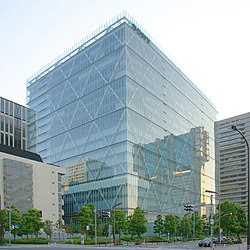
Sony’s Headquarters Complex at Sony City in Minato, Tokyo |
|
|
Native name |
ソニーグループ株式会社 |
|---|---|
|
Romanized name |
Sonī Gurūpu kabushiki kaisha |
| Formerly |
|
| Type | Public |
|
Traded as |
|
| ISIN | JP3435000009 |
| Industry | Conglomerate |
| Founded | 7 May 1946; 76 years ago Nihonbashi, Chūō, Tokyo, Japan[2] |
| Founders |
|
| Headquarters | Sony City,
Minato, Tokyo , Japan |
|
Area served |
Worldwide |
|
Key people |
|
| Products |
|
| Services |
|
| Revenue | |
|
Operating income |
|
|
Net income |
|
| Total assets | |
| Total equity | |
|
Number of employees |
109,700 (2020)[3] |
| Divisions |
|
| Subsidiaries | See list of subsidiaries |
| Website | sony.com |
| Footnotes / references Financials as of fiscal year ended 31 March 2021. References:[5][6] |
Sony Group Corporation (ソニーグループ株式会社, Sonī Gurūpu kabushiki gaisha, SOH-nee), commonly known as simply Sony (stylized as SONY), is a Japanese multinational conglomerate corporation headquartered in Minato, Tokyo, Japan.[7] As a major technology company, it operates as one of the world’s largest manufacturers of consumer and professional electronic products, the largest video game console company and the largest video game publisher. Through Sony Entertainment, it is one of the largest music companies (largest music publisher and second largest record label) and the third largest film studio, making it one of the most comprehensive media companies. It is the largest technology and media conglomerate in Japan. It is also recognized as the most cash-rich Japanese company, with net cash reserves of ¥2 trillion.[8][9][10][11]
Sony, with its 55 percent market share in the image sensor market, is the largest manufacturer of image sensors, the second largest camera manufacturer, and is among the semiconductor sales leaders.[12][11][13] It is the world’s largest player in the premium TV market for a television of at least 55 inches (140 centimeters) with a price higher than $2,500 as well as second largest TV brand by market share and, as of 2020, the third largest television manufacturer in the world by annual sales figures.[14][15][16][17]
Sony Group Corporation is the holding company of the Sony Group (ソニー・グループ, Sonī Gurūpu), which comprises Sony Corporation, Sony Semiconductor Solutions, Sony Entertainment (Sony Pictures, Sony Music), Sony Interactive Entertainment, Sony Financial Group, Sony Creative Products, and others.
The company’s slogan is We are Sony.[18] Their former slogans were The One and Only (1979–1982), It’s a Sony (1981–2005), like.no.other (2005–2009),[19] make.believe (2009–2013),[20] and Be Moved (2013–2021).
Sony has a weak tie to the Sumitomo Mitsui Financial Group (SMFG) corporate group, the successor to the Mitsui keiretsu.[21] Sony is listed on the Tokyo Stock Exchange (in which it is a constituent of the Nikkei 225 and TOPIX Core30 indexes) with an additional listing in the form of American depositary receipts listed in the New York Stock Exchange (traded since 1970, making it the oldest Japanese company to be listed in an American exchange), and was ranked 88th on the 2021 Fortune Global 500 list.[22]
History
Tokyo Tsushin Kogyo
Sony began in the wake of World War II. In 1946, Masaru Ibuka started an electronics shop in Shirokiya,[23] a department store building in the Nihonbashi area of Tokyo. The company started with a capital of ¥190,000[24] and a total of eight employees.[25] On 7 May 1946, Ibuka was joined by Akio Morita to establish a company called Tokyo Tsushin Kogyo (東京通信工業, Tōkyō Tsūshin Kōgyō) (Tokyo Telecommunications Engineering Corporation).[26] The company built Japan’s first tape recorder, called the Type-G.[26][27] In 1958, the company changed its name to «Sony».[28]
Name
Tokyo Tsushin Kogyo founders Morita and Ibuka realized that to achieve success and grow, their business had to expand to the global market, which required labeling their products with a short and easy brand name.[29] While looking for a romanized name, they at first strongly considered using their initials, TTK. The primary reason they did not is that the railway company Tokyo Kyuko was known as TTK.[26] The company occasionally used the acronym «Totsuko» in Japan, but during his visit to the United States, Morita discovered that Americans had trouble pronouncing that name. Another early name that was tried out for a while was «Tokyo Teletech» until Akio Morita discovered that there was an American company already using Teletech as a brand name.[30]
The name «Sony» was chosen for the brand as a mix of two words: one was the Latin word «sonus«, which is the root of sonic and sound, and the other was «sonny«, a common slang term used in 1950s America to call a young boy.[31][32] In 1950s Japan, «sonny boys» was a loan word in Japanese, which connoted smart and presentable young men, which Akio Morita and Masaru Ibuka considered themselves to be.[31]
The first Sony-branded product, the TR-55 transistor radio, appeared in 1955, but the company name did not change to Sony until January 1958.[33]
At the time of the change, it was extremely unusual for a Japanese company to use Roman letters to spell its name instead of writing it in kanji. The move was not without opposition: TTK’s principal bank at the time, Mitsui, had strong feelings about the name. They pushed for a name such as Sony Electronic Industries, or Sony Teletech. Akio Morita was firm, however, as he did not want the company name tied to any particular industry. Eventually, both Ibuka and Mitsui Bank’s chairman gave their approval.[26]
Globalization
A Sony TR-730 transistor radio made in Japan, circa 1960
According to Schiffer, Sony’s TR-63 radio «cracked open the U.S. market and launched the new industry of consumer microelectronics.»[34] By the mid-1950s, American teens had begun buying portable transistor radios in huge numbers, helping to propel the fledgling industry from an estimated 100,000 units in 1955 to 5 million units by the end of 1968.[citation needed]
Sony co-founder Akio Morita founded Sony Corporation of America in 1960.[25] In the process, he was struck by the mobility of employees between American companies, which was unheard of in Japan at that time.[25] When he returned to Japan, he encouraged experienced, middle-aged employees of other companies to reevaluate their careers and consider joining Sony.[25] The company filled many positions in this manner, and inspired other Japanese companies to do the same.[25] Moreover, Sony played a major role in the development of Japan as a powerful exporter during the 1960s, 1970s and 1980s,[35] supplying the U.S. Military with bomb parts used in the Vietnam War.[36] It also helped to significantly improve American perceptions of «made in Japan» products.[37] Known for its production quality, Sony was able to charge above-market prices for its consumer electronics and resisted lowering prices.[37]
In 1971, Masaru Ibuka handed the position of president over to his co-founder Akio Morita. Sony began a life insurance company in 1979, one of its many peripheral businesses. Amid a global recession in the early 1980s, electronics sales dropped and the company was forced to cut prices.[37] Sony’s profits fell sharply. «It’s over for Sony», one analyst concluded. «The company’s best days are behind it.»[37]
Around that time, Norio Ohga took up the role of president. He encouraged the development of the compact disc (CD) in the 1970s and 1980s, and of the PlayStation in the early 1990s. Ohga went on to purchase CBS Records in 1988 and Columbia Pictures in 1989, greatly expanding Sony’s media presence. Ohga would succeed Morita as chief executive officer in 1989.[38][citation needed]
Under the vision of co-founder Akio Morita[39] and his successors, the company had aggressively expanded into new businesses.[35] Part of its motivation for doing so was the pursuit of «convergence», linking film, music and digital electronics via the Internet.[35] This expansion proved unrewarding and unprofitable,[35] threatening Sony’s ability to charge a premium on its products[39] as well as its brand name.[39] In 2005, Howard Stringer replaced Nobuyuki Idei as chief executive officer, marking the first time that a foreigner had run a major Japanese electronics firm. Stringer helped to reinvigorate the company’s struggling media businesses, encouraging blockbusters such as Spider-Man while cutting 9,000 jobs.[35] He hoped to sell off peripheral business and focus the company again on electronics.[39] Furthermore, he aimed to increase cooperation between business units,[39] which he described as «silos» operating in isolation from one another.[40] In a bid to provide a unified brand for its global operations, Sony introduced a slogan known as «make.believe» in 2009.[38][citation needed]
Sony Style store in Bangkok, Thailand
Despite some successes, the company faced continued struggles in the mid- to late-2000s.[35] In 2012, Kazuo Hirai was promoted to president and CEO, replacing Stringer. Shortly thereafter, Hirai outlined his company-wide initiative, named «One Sony» to revive Sony from years of financial losses and bureaucratic management structure, which proved difficult for former CEO Stringer to accomplish, partly due to differences in business culture and native languages between Stringer and some of Sony’s Japanese divisions and subsidiaries. Hirai outlined three major areas of focus for Sony’s electronics business, which include imaging technology, gaming and mobile technology, as well as a focus on reducing the major losses from the television business.[42]
In February 2014, Sony announced the sale of its Vaio PC division to a new corporation owned by investment fund Japan Industrial Partners and spinning its TV division into its own corporation as to make it more nimble to turn the unit around from past losses totaling $7.8 billion over a decade.[43] Later that month, they announced that they would be closing 20 stores.[44] In April, the company announced that they would be selling 9.5 million shares in Square Enix (roughly 8.2 percent of the game company’s total shares) in a deal worth approximately $48 million.[45] In May 2014 the company announced it was forming two joint ventures with Shanghai Oriental Pearl Group to manufacture and market Sony’s PlayStation game consoles and associated software in China.[46]
In 2015, Sony purchased Toshiba’s image sensor business.[47]
It was reported in December 2016 by multiple news outlets that Sony was considering restructuring its U.S. operations by merging its TV & film business, Sony Pictures Entertainment, with its gaming business, Sony Interactive Entertainment. According to the reports, such a restructuring would have placed Sony Pictures under Sony Interactive’s CEO, Andrew House, though House wouldn’t have taken over day-to-day operations of the film studio.[48][49][50] According to one report, Sony was set to make a final decision on the possibility of the merger of the TV, film, & gaming businesses by the end of its fiscal year in March of the following year (2017).[48]
In 2017, Sony sold its lithium-ion battery business to Murata Manufacturing.[51][52][53]
In 2019, Sony merged its mobile, TV and camera businesses.[54][55]
On 1 April 2020, Sony Electronics Corporation was established as an intermediate holding company to own and oversee its electronics and IT solutions businesses.
On 19 May 2020, the company announced that it would rename Sony Group Corporation as of 1 April 2021. Subsequently, Sony Electronics Corporation would be renamed to Sony Corporation.[56] On the same day the company announced that it would turn Sony Financial Holdings (currently Sony Financial Group), of which Sony already owns 65.06% of shares, to a wholly owned subsidiary through a takeover bid.[57]
On 1 April 2021, Sony Corporation was renamed Sony Group Corporation. On the same day, Sony Mobile Communications Inc. absorbed Sony Electronics Corporation, Sony Imaging Products & Solutions Inc., and Sony Home Entertainment & Sound Products Inc. and changed its trade name to Sony Corporation.[58]
Formats and technologies
Sony has historically been notable for creating its own in-house standards for new recording and storage technologies, instead of adopting those of other manufacturers and standards bodies, while its success in the early years owes to a smooth capitalization on the Digital Compact Cassette standard introduced by Philips,[59] with which Sony went on to enjoy a decades-long technological relationship in various areas. Sony (either alone or with partners) has introduced several of the most popular recording formats, including the 3.5-inch floppy disk, compact disc and Blu-ray disc.[60]
Video recording
A rare Japanese market Betamax TV/VCR combo, the Model SL-MV1
Sony introduced U-matic, the world’s first videocassette format, in 1971, but the standard was unpopular for domestic use due to the high price.[61] The company subsequently launched the Betamax format in 1975.[62] Sony was involved in the videotape format war of the early 1980s, when they were marketing the Betamax system for video cassette recorders against the VHS format developed by JVC.[63] In the end, VHS gained critical mass in the marketbase and became the worldwide standard for consumer VCRs.[63]
Betamax is, for all practical purposes, an obsolete format. Sony’s professional-oriented component video format called Betacam, which was derived from Betamax, was used until 2016 when Sony announced it was stopping production of all remaining 1/2-inch video tape recorders and players, including the Digital Betacam format.[64]
In 1985, Sony launched their Handycam products and the Video8 format.[65] Video8 and the follow-on hi-band Hi8 format became popular in the consumer camcorder market. In 1987 Sony launched the 4 mm DAT or Digital Audio Tape as a new digital audio tape standard.[66]
Visual display
Sony held a patent for its proprietary Trinitron until 1996.
Sony introduced the Triluminos Display, the company’s proprietary color reproduction enhancing technology, in 2004, featured in the world’s first LED-backlit LCD televisions.[67] It was widely used in other Sony’s products as well, including computer monitors, laptops, and smartphones.[68] In 2013, Sony released a new line of televisions with an improved version of the technology, which incorporated quantum dots in the backlight system. It was the first commercial use of quantum dots.[69][70]
In 2012, the company revealed a prototype of an ultrafine RGB LED display, which it calls the Crystal LED Display.[71]
Audio recording
First Sony Walkman TPS-L2 from 1979 (Expo in Sony Building at Ginza, Chuo-Ku, Tokyo)
Sony used the Compact Cassette format in many of its tape recorders and players, including the Walkman, the world’s first portable music player.[72] Sony introduced the MiniDisc format in 1992 as an alternative to Philips DCC or Digital Compact Cassette and as a successor to the Compact Cassette.[73] Since the introduction of MiniDisc, Sony has attempted to promote its own audio compression technologies under the ATRAC brand, against the more widely used MP3. Until late 2004, Sony’s Network Walkman line of digital portable music players did not support the MP3 standard natively.
In 2004, Sony built upon the MiniDisc format by releasing Hi-MD. Hi-MD allows the playback and recording of audio on newly introduced 1 GB Hi-MD discs in addition to playback and recording on regular MiniDiscs. In addition to saving audio on the discs, Hi-MD allows the storage of computer files such as documents, videos and photos.
Audio encoding
In 1993, Sony challenged the industry standard Dolby Digital 5.1 surround sound format with a newer and more advanced proprietary motion picture digital audio format called SDDS (Sony Dynamic Digital Sound).[74] This format employed eight channels (7.1) of audio opposed to just six used in Dolby Digital 5.1 at the time.[74] Ultimately, SDDS has been vastly overshadowed by the preferred DTS (Digital Theatre System) and Dolby Digital standards in the motion picture industry. SDDS was solely developed for use in the theatre circuit; Sony never intended to develop a home theatre version of SDDS.[75][76]
Sony and Philips jointly developed the Sony-Philips digital interface format (S/PDIF) and the high-fidelity audio system SACD. The latter became entrenched in a format war with DVD-Audio. Still, neither gained a major foothold with the general public. CDs had been preferred by consumers because of the ubiquitous presence of CD drives in consumer devices until the early 2000s when the iPod and streaming services became available.[77]
In 2015, Sony introduced LDAC, a proprietary audio coding technology which allows streaming high-resolution audio over Bluetooth connections at up to 990 kbit/s at 32 bit/96 kHz. Sony also contributed it as part of the Android Open Source Project starting from Android 8.0 «Oreo», enabling every OEM to integrate this standard into their own Android devices freely. However the decoder library is proprietary, so receiving devices require licenses. On 17 September 2019, the Japan Audio Society (JAS) certified LDAC with their Hi-Res Audio Wireless certification. Currently the only codecs with the Hi-Res Audio Wireless certification are LDAC and LHDC, another competing standard.
Optical storage
Front side of a Sony 200GB Blu-ray disc
Sony demonstrated an optical digital audio disc in 1977 and soon joined hands with Philips, another major contender for the storage technology, to establish a worldwide standard.[78] In 1983, the two company jointly announced the Compact Disc (CD). In 1984, Sony launched the Discman series, an expansion of the Walkman brand to portable CD players. Sony began to improve performance and capacity of the novel format. It launched write-once optical discs (WO) and magneto-optical discs which were around 125MB size for the specific use of archival data storage, in 1986 and 1988 respectively.[79]
In the early 1990s, two high-density optical storage standards were being developed: one was the MultiMedia Compact Disc (MMCD), backed by Philips and Sony, and the other was the Super Density Disc (SD), supported by Toshiba and many others. Philips and Sony abandoned their MMCD format and agreed upon Toshiba’s SD format with only one modification. The unified disc format was called DVD and was introduced in 1997.
Sony was one of the leading developers of the Blu-ray optical disc format, the newest standard for disc-based content delivery. The first Blu-ray players became commercially available in 2006. The format emerged as the standard for HD media over the competing format, Toshiba’s HD DVD, after a two-year-long high-definition optical disc format war.
Sony’s laser communication devices for small satellites rely on the technologies developed for the company’s optical disc products.[80]
Disk storage
In 1983, Sony introduced 90 mm micro diskettes, better known as 3.5-inch (89 mm) floppy disks, which it had developed at a time when there were 4″ floppy disks, and many variations from different companies, to replace the then on-going 5.25″ floppy disks. Sony had great success and the format became dominant. 3.5″ floppy disks gradually became obsolete as they were replaced by current media formats. Sony held more than a 70 percent share of the market when it decided to pull the plug on the format in 2010.[81][82]
Flash memory
In 1998, Sony launched the Memory Stick format, the flash memory cards for use in Sony lines of digital cameras and portable music players. It has seen little support outside of Sony’s own products, with Secure Digital cards (SD) commanding considerably greater popularity. Sony has made updates to the Memory Stick format with Memory Stick Duo and Memory Stick Micro. The company has also released USB flash drive products, branded under the Micro Vault line.[83]
Communication
Sony introduced FeliCa, a contactless IC card technology primarily used in contactless payment, as a result of the company’s joint development and commercialization of Near-Field Communication (NFC) with Philips. The standard is largely offered in two forms, either chips embedded in smartphones or plastic cards with chips embedded in them. Sony plans to implement this technology in train systems across Asia.[84]
In 2019, Sony launched the ELTRES, the company’s proprietary low-power wide-area wireless communication (LPWAN) standard.[85]
Video Gaming
Until 1991, Sony had little direct involvement with the video game industry. The company supplied components for other consoles, such as the sound chip for the Super Famicom from Nintendo, and operated a video game studio, Sony Imagesoft.[86] As part of a joint project between Nintendo and Sony that began as early as 1988, the two companies worked to create a CD-ROM version of the Super Famicom,[87] though Nintendo denied the existence of the Sony deal as late as March 1991.[88] At the Consumer Electronics Show in June 1991, Sony revealed a Super Famicom with a built-in CD-ROM drive that incorporated Green Book technology or CD-i, called «Play Station» (also known as SNES-CD). However, a day after the announcement at CES, Nintendo announced that it would be breaking its partnership with Sony, opting to go with Philips instead but using the same technology.[89] The deal was broken by Nintendo after they were unable to come to an agreement on how revenue would be split between the two companies.[89] The breaking of the partnership infuriated Sony President Norio Ohga, who responded by appointing Kutaragi with the responsibility of developing the PlayStation project to rival Nintendo.[89]
The sole remaining prototype of Sony’s original «PlayStation», a Super NES with a built-in CD-ROM drive
At that time, negotiations were still on-going between Nintendo and Sony, with Nintendo offering Sony a «non-gaming role» regarding their new partnership with Philips. This proposal was swiftly rejected by Kutaragi who was facing increasing criticism over his work with regard to entering the video game industry from within Sony. Negotiations officially ended in May 1992 and in order to decide the fate of the PlayStation project, a meeting was held in June 1992, consisting of Sony President Ohga, PlayStation Head Kutaragi and several senior members of Sony’s board. At the meeting, Kutaragi unveiled a proprietary CD-ROM-based system he had been working on which involved playing video games with 3D graphics to the board. Eventually, Sony President Ohga decided to retain the project after being reminded by Kutaragi of the humiliation he suffered from Nintendo. Nevertheless, due to strong opposition from a majority present at the meeting as well as widespread internal opposition to the project by the older generation of Sony executives, Kutaragi and his team had to be shifted from Sony’s headquarters to Sony Music, a completely separate financial entity owned by Sony, so as to retain the project and maintain relationships with Philips for the MMCD development project (which helped lead to the creation of the DVD)
Continued research and development
In 2021, the WIPO’s annual review of the World Intellectual Property Indicators report ranked Sony’s as ninth in the world for the number of patent applications published under the PCT System. 1,793 patent applications were published by Sony during 2020.[90] This position is up from their previous ranking as 13th in 2019 with 1,566 applications.[91]
Business units
Best known for its electronic products, Sony offers a wide variety of product lines in many areas. At its peak, it was dubbed as a «corporate octopus», for its sprawling ventures from private insurance to chemicals to cosmetics to home shopping to a Tokyo-based French food joint, in addition its core businesses such as electronics and entertainment.[39] Even after it has unwound many business units including Sony Chemicals and Vaio PC, Sony still runs diverse businesses.
As of 2020, Sony is organized into the following business segments: Game & Network Services (G&NS), Music, Pictures, Electronics Products & Solutions (EP&S), Imaging & Sensing Solutions (I&SS), Financial Services, and Others.[92] Usually, each business segment has a handful of corresponding intermediate holding companies under which all the related businesses are folded into, such as Columbia Records being part of Sony Music Group, a subsidiary and, at the same time, a holding company for Sony’s music businesses, along with SMEJ.
Electronics Products & Solutions
Sony Corporation (Sony Electronics Corporation until 1 April 2021[93]) is the electronics business unit of the Sony Group. It primarily conducts research and development (R&D), planning, designing, manufacturing and marketing for electronics products. Sony Global Manufacturing & Operations Corporation (SGMO) is a wholly-owned subsidiary of Sony Corporation and responsible for managing manufacturing operations both in Japan and overseas, through its own factories as well as third party contract manufacturers.
Audio
In 1979, Sony released the world’s first portable music player, the Walkman, bundled with the MDL-3L2 headphones. This line fostered a fundamental change in music listening habits by allowing people to carry music with them and listen to music through lightweight headphones.[72][94] Originally used to refer to portable audio cassette players, the Walkman brand has been widely adopted by the company to encompass its portable digital audio and video players as well as a line of former Sony Ericsson mobile phones. In the case of optical disc players, the Discman brand was used until the late 1990s. In 1999 Sony’s first portable digital audio players were introduced; one was a player using Memory Stick flash storage created by the Walkman division, and the other was a smaller pen-sized player with embedded flash storage created by the Vaio division; both accompanied with Sony’s OpenMG copyright protection technology and PC software for music transfer.[95][96] Sony continue to develop Walkman digital audio players.
Sony is a major audio products manufacturer and one of the active noise control technology leaders.[97][98]
Video
The logo of Bravia television. Its backronym is «Best Resolution Audio Visual Integrated Architecture».
Sony produced the TV8-301, the world’s first all-transistor television, in 1959.[99] In 1968, the company introduced the Trinitron brand name for its lines of aperture grille cathode ray tube televisions and afterwards computer monitors. Sony stopped production of Trinitron for most markets, but continued producing sets for markets such as Pakistan, Bangladesh and China. Sony discontinued its series of Trinitron computer monitors in 2005. The company discontinued the last Trinitron-based television set in the US in early 2007. The end of Trinitron marked the end of Sony’s analog television sets and monitors.
Sony used the LCD WEGA name for its LCD TVs until summer 2005. The company then introduced the BRAVIA name. BRAVIA is an in-house brand owned by Sony which produces high-definition LCD televisions, projection TVs and front projectors, home cinemas and the BRAVIA home theatre range. All Sony high-definition flat-panel LCD televisions in North America have carried the logo for BRAVIA since 2005. In 2006, Sony lost its decades-long No.1 market share in the global television market. In November 2007, the Sony XEL-1, the first OLED television, was released and manufactured for two years. Later in 2013, Sony demonstrated the first 4K OLED television.[100][101] As of 2012, Sony was the third-largest maker of televisions in the world and the business unit had been unprofitable for eight consecutive years.[102]
From 2011, Sony started restructuring of its loss-making television business, mainly by downsizing business units and outsourcing the manufacturing of display panels to the companies like Sharp Corporation, LG Display, and Samsung Electronics.[103] In December 2011, Sony agreed to sell all stake in an LCD joint venture with Samsung Electronics (S-LCD) for about $940 million.[104] On 28 March 2012, Sony and Sharp announced that they have agreed to further amend the joint venture agreement originally executed by the parties in July 2009, as amended in April 2011, for the establishment and operation of Sharp Display Products Corporation («SDP»), a joint venture to produce and sell large-sized LCD panels and modules.[105] The agreement was eventually terminated as Sony parted ways.[106] Sony’s small-sized LCD business subsidiary and medium-to-large-sized OLED display business unit were spun off and became part of Japan Display and JOLED, respectively.[107]
In 2017, Sony launched OLED televisions under the BRAVIA brand.[108]
Also, Sony has sold a range of tapes, discs, recorders and players for videocassette, DVD, and Blu-ray formats for decades.
Photography and videography
A Sony α77 DSLR camera
Sony offers a wide range of digital cameras. Its point-and-shoot models are branded Cyber-shot, while DSLRs and mirrorless models are branded Alpha, though Sony no longer makes DSLRs. It also produces action cameras and camcorders, with the company’s cinema-grade products being sold under the CineAlta name.
Sony demonstrated a prototype of the Sony Mavica in 1981 and released it for the consumer market in 1988. The first Cyber-shot was introduced in 1996. Sony’s market share of the digital camera market fell from a high of 20% to 9% by 2005.[109][40]
Sony entered the market for digital single-lens reflex cameras in 2006 when it acquired the camera business of Konica Minolta. Sony rebranded the company’s line of cameras as its Alpha line. Sony is the world’s third largest manufacturer of the cameras, behind Canon and Nikon respectively.
In 2010, Sony introduced their first mirrorless interchangeable-lens cameras, which were the NEX-3 and the NEX-5. They also started a new lens mount system, which was the E-mount. There were quite a few NEX models out there, when Sony decided to melt the NEX series into the Alpha series. The first Alpha MILC was the α3000, which was introduced in August 2013. It was followed by the Full-Frame α7 and α7R in October, then the successors of the NEX-5, the NEX-6 and NEX-7, the α5000 and the α6000 in 2014. The α6000 became the most popular MILC ever and Sony became the largest MILC manufacturer.
Computing
Notebook Sony Vaio. Sony has axed its loss-making PC business in 2014.
Sony produced computers (MSX home computers and NEWS workstations) during the 1980s. The company withdrew from the computer business around 1990. Sony entered again into the global computer market under the new VAIO brand, began in 1996. Short for «Video Audio Integrated Operation», the line was the first computer brand to highlight visual-audio features.[40]
Sony faced considerable controversy when some of its laptop batteries exploded and caught fire in 2006, resulting in the largest computer-related recall to that point in history.[110][111][112]
In a bid to join the tablet computer market, the company launched its Sony Tablet line of Android tablets in 2011. Since 2012, Sony’s Android products have been marketed under the Xperia brand used for its smartphones.[113]
On 4 February 2014, Sony announced that it would sell its VAIO PC business due to poor sales[114] and Japanese company Japan Industrial Partners (JIP) will purchase the VAIO brand, with the deal finalized by the end of March 2014.[115] As of 2018, Sony maintained a 5% stake in the new, independent company.
Healthcare and biotechnology
Sony has targeted medical, healthcare and biotechnology business as a growth sector in the future. The company acquired iCyt Mission Technology, Inc. (renamed Sony Biotechnology Inc. in 2012), a manufacturer of flow cytometers, in 2010 and Micronics, Inc., a developer of microfluidics-based diagnostic tools, in 2011.
In 2012, Sony announced that it would acquire all shares of So-net Entertainment Corporation, the largest shareholder of M3, Inc., an operator of portal sites (m3.com, MR-kun, MDLinx and MEDI:GATE) for healthcare professionals.
On 28 September 2012, Olympus and Sony announced that the two companies will establish a joint venture to develop new surgical endoscopes with 4K resolution (or higher) and 3D capability.[116] Sony Olympus Medical Solutions Inc. (Sony 51%, Olympus 49%) was established on 16 April 2013.[117]
On 28 February 2014, Sony, M3 and Illumina established a joint venture called P5, Inc. to provide a genome analysis service for research institutions and enterprises in Japan.[118]
Mobility
Xperia, the product device name for a range of smartphones from Sony
A historical Sony CMD-CD5 mobile phone
In 2000, Sony was a marginal player in the mobile phone market with a share of less than 1 percent. In 2001, Sony entered into a joint venture with Swedish telecommunications company Ericsson, forming Sony Ericsson Mobile Communications.[119] Initial sales were rocky, and the company posted losses in 2001 and 2002. However, Sony Ericsson reached a profit in 2003. The company distinguished itself with multimedia-capable mobile phones, which included features such as cameras. These were unusual at the time. Despite their innovations, Sony Ericsson faced intense competition from Apple’s iPhone, which was released in 2007. From 2008 to 2010, amid a global recession, Sony Ericsson slashed its workforce by several thousand. In 2009, Sony Ericsson was the fourth-largest mobile phone manufacturer in the world (after Nokia, Samsung and LG).[120] By 2010, its market share had fallen to sixth place.[121] Sony acquired Ericsson’s share of the venture in 2012 for over US$1 billion.[119] Sony Mobile focuses exclusively on the smartphone market under the Xperia brand.
In 2013, Sony contributed to around two percent of the mobile phone market with 37 million mobile phones sold.[122] Sony Mobile’s sales reached a peak in 2014 with 40 million handsets, the volume has since decreased. Sony shipped 13.5 million phones in 2017, 6.5 million in 2018, and 2.9 million handsets in FY 2020.[123]
Robotics
Since the late 1990s, Sony has released numerous consumer robots, including dog-shaped robots called AIBO, a music playing robot called Rolly, and a humanoid robot called QRIO. Despite being a pioneer in the field, Sony had ceased robotics-related operations for 10 years due to financial difficulties, until it decided to revive them in 2016.[124]
In 2015, Sony partnered with an autonomous driving startup ZMP INC. to establish an aerial surveillance and reconnaissance drone manufacturer named Aerosense.[125] At the CES 2021, Sony unveiled a drone with the brand Airpeak, the smallest of its kind that can incorporate a Sony Alpha camera according to the company, entering the drone business on its own for the first time.[126]
Imaging & Sensing Solutions
Sony traces its roots in the semiconductor business back to 1954, when it became the first Japanese company to commercialize the transistor, invented and licensed by Bell Labs, whilst some of the biggest and well-established names in Japan at the time like Toshiba and Mitsubishi Electric initially stuck with vacuum tubes they had been thriving on; despite being an expert on the vacuum tube himself, Ibuka saw potential of the novel technology and had Morita negotiate the terms for licensing, making Sony into one of the earliest and the youngest licensees of the transistor, together with Texas Instruments.[127][128][129] In 1957, Sony employee Leo Esaki and his colleagues invented a tunnel diode (usually referred to as Esaki diode) by which they discovered the quantum tunneling effect in solids, for which Esaki received the Nobel prize in Physics in 1973.[130] Sony has commanded a dominant share in the charge-coupled device market.[131]
As of 2020, Sony is the world’s largest manufacturer of CMOS image sensors as its chips are widely used in digital cameras, tablet computers, smartphones, drones and more recently, self-driving systems in automobiles.[132]
As of 2020, the company, through its chip business arm Sony Semiconductor Solutions, designs, manufactures, and sells a wide range of semiconductors and electronic components, including image sensors (HAD CCD, Exmor), image processors (BIONZ), laser diodes, system LSIs, mixed-signal LSIs, emerging memory storage, emerging displays (microLED, microOLED, and holographic display), multi-functional microcomputer (SPRESENSE), etc.[133]
In 2020, Sony has launched the first intelligent vision sensors with AI edge computing capabilies.[134]
Game & Network Services
Sony Interactive Entertainment (formerly Sony Computer Entertainment) is best known for producing the popular line of PlayStation consoles. The line grew out of a failed partnership with Nintendo. Originally, Nintendo requested Sony to develop an add-on for its Super Nintendo Entertainment System that would play CD-ROMs. In 1991 Sony announced the add-on, as well as a dedicated console known as the «Play Station». However, a disagreement over software licensing for the console caused the partnership to fall through. Sony then continued the project independently.
Launched in 1994, the first PlayStation gained 61% of global console sales and broke Nintendo’s long-standing lead in the market.[135] Sony followed up with the PlayStation 2 in 2000, which was even more successful. The console has become the most successful of all time, selling over 150 million units as of 2011. Sony released the PlayStation 3, a high-definition console, in 2006. It was the first console to use the Blu-ray format, and was considerably more expensive than the competitors Xbox 360 and Wii due to the Cell processor.[40]
Early on, poor sales performance resulted in significant losses for the company, pushing it to sell the console at a loss.[136] The PlayStation 3 sold generally more poorly than its competitors in the early years of its release but managed to overtake the Xbox 360 in global sales later on.[137] It later introduced the PlayStation Move, an accessory that allows players to control video games using motion gestures.
Sony extended the brand to the portable games market in 2004 with the PlayStation Portable (PSP). The console has sold reasonably, but has taken a second place to a rival handheld, the Nintendo DS. Sony developed the Universal Media Disc (UMD) optical disc medium for use on the PlayStation Portable. Early on, the format was used for movies, but it has since lost major studio support. Sony released a disc-less version of its PlayStation Portable, the PSP Go, in 2009. The company went on to release its second portable video game system, PlayStation Vita, in 2011 and 2012. Sony launched its fourth console, the PlayStation 4, on 15 November 2013, which as of 31 December 2017 has sold 73.6 million units globally.[138]
On 18 March 2014, at GDC, president of SCE Worldwide Studios Shuhei Yoshida announced their new virtual reality technology dubbed Project Morpheus, and later named PlayStation VR, for PlayStation 4. The headset brought VR gaming and non-gaming software to the company’s console. According to a report released by Houston-based patent consulting firm LexInnova in May 2015, Sony is leading the virtual reality patent race. According to the firm’s analysis of nearly 12,000 patents or patent applications, Sony has 366 virtual reality patents or patent applications.[139] PlayStation VR was released worldwide on 13 October 2016.[140]
On 31 March 2019, the successor to the PlayStation 4 was announced and on 12 November 2020, the PlayStation 5 was released in North America, Australia, New Zealand, Japan, South Korea, and Singapore. The console was launched in Indonesia on 22 January 2021. Upon completion of the fiscal quarter, Sony sold 4.5 million PlayStation 5 consoles, keeping pace with the best-selling console of all time, the PlayStation 2.[141]
Pictures and Music
Sony Entertainment has two divisions: Sony Pictures Entertainment, Sony Music Group (Sony Music Entertainment, Sony Music Publishing). Sony USA previously owned and operated Sony Trans Com: a technology business that provided in-flight entertainment programming as well as video and audio playback equipment for the airline industry. Sony had purchased the business from Sundstrand Corp. in 1989 and subsequently sold it to Rockwell Collins in 2000.[142][143]
In 2012, Sony rolled most of its consumer content services (including video, music and gaming) into the Sony Entertainment Network, the predecessor of PlayStation Network.
Sony Pictures Entertainment
Sony Pictures Entertainment Inc. (SPE) is the television and film production/distribution unit of Sony. With 12.5% box office market share in 2011, the company was ranked third among movie studios.[144] Its group sales in 2010 were US$7.2 billion.[145][146] The company has produced many notable movie franchises, including Spider-Man, The Karate Kid and Men in Black. It has also produced the popular television game shows Jeopardy! and Wheel of Fortune.
Sony entered the television and film production market when it acquired Columbia Pictures Entertainment in 1989 for $3.4 billion. Columbia lives on in the Sony Pictures Motion Picture Group, a division of SPE which in turn owns Columbia Pictures and TriStar Pictures among other film production and distribution companies such as Screen Gems, Sony Pictures Classics, Sony Pictures Home Entertainment. SPE’s television division is known as Sony Pictures Television.
For the first several years of its existence, Sony Pictures Entertainment performed poorly, leading many to suspect the company would sell off the division.[147] In 2006 Sony started using ARccOS Protection on some of their film DVDs, but later issued a recall.[148]
In late 2014, Sony Pictures became the target of a hack attack from a clandestine group called Guardians of Peace, weeks before releasing the anti-North Korean comedy film The Interview.[149]
Sony Music Group and SMEJ
Sony Music Entertainment (also known as SME or Sony Music) is the largest global recorded music company of the «big three» record companies and is controlled by Sony Corporation of America, the United States subsidiary of Sony.
In one of its largest-ever acquisitions, Sony purchased CBS Record Group in 1988 for US$2 billion.[150] In the process, Sony partnered and gained the rights to the ATV catalogue of Michael Jackson, considered by the Guinness Book of World Records to be the most successful entertainer of all time. The acquisition of CBS Records provided the foundation for the formation of Sony Music Entertainment, which Sony established in 1991.
In 1968, Sony and CBS Records had formed a 50:50 joint-venture CBS/Sony Records, later renamed CBS/Sony Group, in Japan. When CBS Records was acquired, a 50% stake in CBS/Sony Group owned by CBS was also transferred to Sony. In March 1988, four wholly owned subsidiaries were folded into CBS/Sony Group and the company was renamed as Sony Music Entertainment Japan (SMEJ). It operates independently of Sony Music as it is directly owned by Japanese Sony.
In 2004, Sony entered into a joint venture with Bertelsmann AG, merging Sony Music Entertainment with Bertelsmann Music Group to create Sony BMG. In 2005, Sony BMG faced a copy protection scandal, because its music CDs had installed malware on users’ computers that was posing a security risk to affected customers.[151] In 2007, the company acquired Famous Music for US$370 million, gaining the rights to the catalogues of Eminem and Akon, among others. Sony bought out Bertelsmann’s share in Sony BMG and formed a new Sony Music Entertainment in 2008. Since then, the company has undergone management changes.
Sony purchased digital music recognition company Gracenote for US$260 million in 2008.[152] Tribune Media Company acquired Gracenote from Sony in 2014 for $170 million.[153]
Besides its record label, Sony operates other music businesses. In 1995, Sony merged its publisher with Michael Jackson’s ATV Music Publishing, forming Sony/ATV Music Publishing. At the time, the publishing company was the second largest of its kind in the world. The company owns the publishing rights to over 4 million compositions, including The Beatles’ Lennon-McCartney catalogue, Bob Dylan, Eminem, Lady Gaga, Sam Smith, Ed Sheeran, and Taylor Swift.
In 2012, Sony/ATV acquired a majority stake in EMI Music Publishing, becoming the world’s largest music publishing company. In 2018, Sony bought the rest of the shares in the publisher, making it a wholly owned subsidiary.[154][155] Since 2016, Sony owns all of Sony/ATV.[156]
Anime
Sony’s entering into the Japanese animation, or anime, business happened in 1995 when its Sony Music Entertainment Japan (SMEJ) division established Aniplex as its subsidiary managing creative productions, which founded A-1 Pictures, the first anime studio of Sony, ten years later. Since then, through group-wide and international ventures,[157] Sony has solidified its position in the industry, elevating the business to what is called the «fourth pillar of its entertainment portfolio» according to The Nikkei.[158]
The anime business operations of Sony are scattered around the group, mainly in its Pictures and Music units, as follows: SMEJ’s notable related businesses include Aniplex and its subsidiaries CloverWorks and A-1 Pictures while Sony Pictures Entertainment Japan (SPEJ) operates anime-oriented TV channels like Animax, Kids Station; Aniplex and U.S.-headquartered Sony Pictures co-own U.S.-based anime distribution company Crunchyroll, which since 2022, has become the successor company to Funimation, which it acquired in 2017 and included subsidiaries such as Wakanim (absorbing into Crunchyroll itself) and Madman Anime (to be rebranded as Crunchyroll Pty. Ltd.)[159]
In December 2020, Funimation announced that it would buy AT&T’s animation business Crunchyroll for $1.175 billion, which would help the company to compete more globally with entertainment giants such as Netflix.[160] This acquisition was completed in August 2021.[161]
Financial Services
Headquarters of Sony Financial Group in Tokyo, Japan
Sony Financial Group is a holding company for Sony’s financial services business which includes Sony Life (in Japan and the Philippines), Sony Assurance, Sony Bank, etc. The unit proved to be the most profitable of Sony’s businesses in FY 2005, earning $1.7 billion in profit.[39] Sony Financial’s low fees have aided the unit’s popularity while threatening Sony’s premium brand name.[39]
Others
Electric vehicles and batteries
A company behind the commercialization of lithium-ion battery,[162] Sony had been exploring the possibility to manufacture the batteries for electric vehicles.[163][164][165] In 2014, Sony participated within NRG Energy eVgo Ready for Electric Vehicle (REV) program, for EV charging parking lots.[166] However, the company then decided to sell its lithium-ion battery business to Murata Manufacturing in 2016.[167]
In 2015, Sony invested $842 thousand in ZMP INC., drawing speculations that it is contemplating developing self-driving cars.[168] In January 2020, Sony unveiled a concept electric car at the Consumer Electronics Show, named Vision-S, designed in collaboration with components manufacturer Magna International.[169] At the occasion, Sony also stated its goal of developing technology for the automotive sector, especially concerning autonomous driving, sensors, and in-car entertainment.[170]
In 2022, Sony Group and Honda launched a joint venture for their electric vehicle partnership, Sony Honda Mobility (SHM), which would deliver its first electric vehicles by 2026 and sell them online, starting in the United States and Japan.[171][172] The joint venture announced their new «Afeela» brand and its first prototype model at the CES 2023.[173]
Corporate information
Institutional ownership
Sony is a kabushiki gaisha registered to the Tokyo Stock Exchange in Japan and the New York Stock Exchange for overseas trading. As of 31 March 2020, the largest shareholders of Sony are as follows:[174]
- Citibank (as depositary bank for American depositary receipt holders) (9.4%)
- The Master Trust Bank of Japan–nominated investment trusts (main account) (8.2%)
- Japan Trustee Services Bank–nominated investment trusts
- Main trust account (6.1%)
- Trust account 7 (2.4%)
- Trust account 5 (2.1%)
- JPMorgan Chase Bank 385632 (3.2%)
Finances
As of July 2020, Sony, one of the largest Japanese companies by market capitalization and operating profit, was valued at over $90 billion. At the same period, it was also recognized as the most cash-rich Japanese company, with its net cash reserves of ¥1.8 trillion.[175]
The company was immensely profitable throughout the 1990s and early 2000s in part because of the success of its new PlayStation line. The company encountered financial difficulty in the mid- to late-2000s due to a number of factors: the global financial crisis, increased competition for PlayStation, and the devastating Japanese earthquake of 2011. The company faced three consecutive years of losses leading up to 2011.[176] While noting the negative effects of intervening circumstances such as natural disasters and fluctuating currency exchange rates, the Financial Times criticized the company for its «lack of resilience» and «inability to gauge the economy,» voicing skepticism about Sony’s revitalization efforts, given a lack of tangible results.[176]
In September 2000 Sony had a market capitalization of $100 billion; but by December 2011 it had plunged to $18 billion, reflecting falling prospects for Sony but also reflecting grossly inflated share prices of the ‘dot-com bubble’ years.[177] Net worth, as measured by stockholder equity, has steadily grown from $17.9 billion in March 2002 to $35.6 billion through December 2011.[178] Earnings yield (inverse of the price to earnings ratio) has never been more than 5% and usually much less; thus Sony has always traded in over-priced ranges with the exception of the 2009 market bottom.
On 9 December 2008, Sony announced that it would be cutting 8,000 jobs, dropping 8,000 contractors and reducing its global manufacturing sites by 10% to save $1.1 billion per year.[179]
In April 2012, Sony announced that it would reduce its workforce by 10,000 (6% of its employee base) as part of CEO Kaz Hirai’s effort to get the company back into the black. This came after a loss of 520 billion yen (roughly US$6.36 billion) for fiscal 2012, the worst since the company was founded. Accumulation loss for the past four years was 919.32 billion-yen.[180][181] Sony planned to increase its marketing expenses by 30% in 2012.[182] 1,000 of the jobs cut come from the company’s mobile phone unit’s workforce. 700 jobs will be cut in the 2012–2013 fiscal year and the remaining 300 in the following fiscal year.[183] Sony had revenues of ¥6.493 trillion in 2012 and maintained large reserves of cash, with ¥895 billion on hand as of 2012. In May 2012, Sony’s market capitalization was valued at about $15 billion.[184]
| Geographic region | Total sales (in millions of ¥) |
|---|---|
| Japan | 1,873,219 |
| United States | 2,512,345 |
| Europe | 2,307,658 |
| Other areas | 2,041,270 |
In January 2013, Sony announced it was selling its US headquarters building for $1.1 billion to a consortium led by real estate developer The Chetrit Group.[186]
On 28 January 2014, Moody’s Investors Services dropped Sony’s credit rating to Ba1—»judged to have speculative elements and a significant credit risk»—saying that the company’s «profitability is likely to remain weak and volatile.»[187]
On 6 February 2014, Sony announced it would trim as many as 5,000 jobs as it attempts to sell its PC business and focus on mobile and tablets.[188]
In 2014,[189] Sony South Africa closed its TV, Hi-Fi and camera divisions[190] with the purpose of reconsidering its local distribution model and, in 2017, it returned[191][192] facilitated by Premium Brand Distributors (Pty) Ltd.
| Segment | Revenue Financial Year 2017 (in millions of ¥) | Financial Year 2018 (in millions of ¥) | Change | Percentage of Sales | Percentage Change (FY 2017 to FY 2018) |
|---|---|---|---|---|---|
| Game & Network Services | 1’943’812 | 2’310’872 | 367’060 | 22.8 | 18.9 |
| Music | 799’995 | 807’489 | 7’494 | 9.4 | 0.9 |
| Pictures | 1’011’067 | 986’873 | −24’194 | 11.8 | −2.4 |
| Home Entertainment & Sound | 1’222’733 | 1’155’411 | −67’322 | 14.3 | −5.5 |
| Imaging Products and Solutions | 655’892 | 670’450 | 14’558 | 7.7 | 2.2 |
| Mobile Communications | 723’742 | 498’000 | −225’742 | 8.5 | −31.2 |
| Semiconductors | 726’892 | 770’622 | 43’730 | 8.5 | 6.0 |
| Financial Services | 1’228’377 | 1’282’539 | 54’162 | 14.4 | 4.4 |
| All Other | 407’174 | 345’737 | 61’437 | 1.3 | −31.0 |
| Total | 8’719’684 | 8’827’993 | 108’309 |
In November 2018, Sony posted its earning report for the second quarter showing it has lost about US$480 million in the mobile phone division,[194] prompting another round of downsizing in the unit, including the closure of a manufacturing plant and halving of its workforce.[195][196]
Environmental record
In November 2011, Sony was ranked ninth (jointly with Panasonic) in Greenpeace’s Guide to Greener Electronics.[197] This chart grades major electronics companies on their environmental work. The company scored 3.6/10, incurring a penalty point for comments it has made in opposition to energy efficiency standards in California. It also risks a further penalty point in future editions for being a member of trade associations that have commented against energy efficiency standards.[198] Together with Philips, Sony receives the highest score for energy policy advocacy after calling on the EU to adopt an unconditional 30% reduction target for greenhouse gas emissions by 2020. Meanwhile, it receives full marks for the efficiency of its products.[198] In June 2007, Sony ranked 14th on the Greenpeace guide.[199] Sony fell from its earlier 11th-place ranking due to Greenpeace’s claims that Sony had double standards in their waste policies.[200]
As of May 2018 Greenpeace’s 2017 Guide to Greener Electronics rated Sony approximately in the middle among electronics manufacturers with a grade of D+.[201]
Since 1976, Sony has had an Environmental Conference.[202] Sony’s policies address their effects on global warming, the environment, and resources. They are taking steps to reduce the amount of greenhouse gases that they put out as well as regulating the products they get from their suppliers in a process that they call «green procurement».[203] Sony has said that they have signed on to have about 75 percent of their Sony Building running on geothermal power. The «Sony Take Back Recycling Program» allow consumers to recycle the electronics products that they buy from Sony by taking them to eCycle (Recycling) drop-off points around the U.S. The company has also developed a biobattery that runs on sugars and carbohydrates that works similarly to the way living creatures work. This is the most powerful small biobattery to date.[204]
In 2000, Sony faced criticism for a document entitled «NGO Strategy» that was leaked to the press. The document involved the company’s surveillance of environmental activists in an attempt to plan how to counter their movements. It specifically mentioned environmental groups that were trying to pass laws that held electronics-producing companies responsible for the cleanup of the toxic chemicals contained in their merchandise.[205]
Cartel
In 2007 an investigation launched in 2002 by the European Commission culminated in Sony, Fuji and Maxell receiving a total of 110 million US dollar fine for fixing professional videotape prices between the years 1999 and 2002 through regular meetings and other illegal contracts; at the time the three corporations shared a combined 85% control of the market. Sony’s part of the fine was raised by a third for trying to obstruct the investigation by refusing to answer inquiries made by the EU officials and shredding of evidence during the multiple law-enforcement raids.[206][207] During the year 2001 prior to the investigation Sony sold professional videotapes for a total of 115 million euros inside the EU.
- EYE SEE project
Sony Corporation is actively involved in the EYE SEE project conducted by UNICEF. EYE SEE digital photography workshops have been run for children in Argentina, Tunisia, Mali, South Africa, Ethiopia, Madagascar, Rwanda, Liberia and Pakistan.[208][209] - South Africa Mobile Library Project
Sony assists The South Africa Primary Education Support Initiative (SAPESI) through financial donations and children book donations to the South Africa Mobile Library Project.[210] - The Sony Canada Charitable Foundation
The Sony Canada Charitable Foundation (SCCF) is a non-profit organization which supports three key charities; the Make-A-Wish Canada, the United Way of Canada and the EarthDay and ECOKIDS program. - Sony Foundation and You Can
After the 2011 Queensland floods and Victorian bushfires, Sony Music released benefit albums with money raised going to the Sony Foundation.[211] You Can is the youth cancer program of Sony Foundation.[212] - Open Planet Ideas Crowdsourcing Project
Sony launched its Open Planet Ideas Crowdsourcing Project, in partnership with the World Wildlife Fund and the design group, IDEO.[213] - Street Football Stadium Project
On the occasion of the 2014 World Cup in Brazil, Sony partnered with streetfootballworld and launched the Street Football Stadium Project to support football-based educational programmes in local communities across Latin America and Brazil.[214] More than 25 Street Stadiums were developed since the project’s inception.[215] - The Sony Global Relief Fund for COVID-19
During the COVID-19 pandemic, Sony launched a relief fund in line with other media and tech companies to aid individuals working in the medical, education, and entertainment sectors.[216]
See also
- List of acquisitions by Sony
- List of assets owned by Sony
- List of libraries owned by Sony
- List of companies of Japan
Notes
- ^ Since April 2021, the «Sony Corporation» legal name is used for Sony Group’s electronics business that was previously known as «Sony Electronics Corporation».
References
- ^ «Change of the Sony entity for License Agreements, etc». www.sony.net. Sony Group Corporation. 2021-04-01. Retrieved 2021-05-07.
- ^ «Sony Corporate History». www.sony.com. Retrieved 2021-04-03.
- ^ «Sony». Fortune.
- ^ «Organization Data, Corporate Info». Sony Corporation. 2019-08-01. Retrieved 2020-06-05.
- ^ «Financial Statements and Consolidated Financial Results» (PDF). sony.com. SONY Corporation. Archived (PDF) from the original on 2021-05-04. Retrieved 2021-06-27.
- ^ «Corporate Data» (PDF). Sony Corporation. 2019-03-31. Archived (PDF) from the original on 2019-07-28. Retrieved 2019-04-03.
- ^ «Access & Map.» Sony Global. Retrieved 2 April 2021. «1–7–1 Konan Minato-ku, Tokyo 108-0075, Japan» – Map – Address in Japanese: «〒108-0075 東京都港区港南1–7–1»
- ^ Aswad, Jem (2019-07-17). «Sony Unites Recorded Music and Publishing Under One Company». Variety. Retrieved 2021-05-21.
- ^ «Sony embraces its inner conglomerate». Reuters. 2020-05-02. Retrieved 2020-07-03.
- ^ «Sony in US$2.3 billion deal, becomes the world’s biggest music publisher the third largest movie studio». Archived from the original on 2021-01-15. Retrieved 2018-05-29.
- ^ a b «Sony’s key image sensor business hit by smartphone market decline». Nikkei Asian Review.
- ^ «Top 20 semiconductor sales leaders for Q1 2016». www.electronicspecifier.com. Retrieved 2020-06-01.
- ^ «2019 Market Share Data Shows Canon and Sony Growing, Nikon Shrinking | PetaPixel». petapixel.com. 2020-08-14. Retrieved 2021-05-21.
- ^ «Global LCD TV manufacturer market share from 2008 to 2017». Statista. Retrieved 2017-02-26.
- ^ «Samsung tops global TV market for 15th consecutive year». FlatpanelsHD. Retrieved 2021-05-21.
- ^ Alekseenko, Artem (2021-03-04). «LG and Sony Led OLED TV Gains in Advanced TV Market in Q4». DisplayDaily. Retrieved 2021-05-21.
- ^ «How Samsung fell behind Sony and LG in the premium TV market». Reuters. 2018-05-02. Retrieved 2020-06-01.
- ^ «Sony Group Portal – Motion Logo». www.sony.com.
- ^ «Sony like.no.other Global Brand Development». Blind. Archived from the original on 2016-11-17. Retrieved 2016-11-16.
- ^ Christopher MacManus (2009-09-02). «Sony Insider. 2010-10-27. Retrieved 2016-08-07». Sonyinsider.com. Archived from the original on 2018-06-16. Retrieved 2017-04-21.
- ^ Morck, R. K.; Nakamura, M. (2005). «A Frog in a Well Knows Nothing of the Ocean: A History of Corporate Ownership in Japan» (PDF). In Morck, Randall K. (ed.). A History of Corporate Governance around the World: Family Business Groups to Professional Managers. University of Chicago Press. pp. 367–466. ISBN 0-226-53680-7. Archived (PDF) from the original on 2016-05-09.
- ^ «Sony 2020 Global 500 – Fortune». Fortune.
- ^ Sundberg, Stephen (2016-09-18). «Shirokiya Department Store, c. 1910–1940. | Old Tokyo». Old Tokyo. Archived from the original on 2012-09-18. Retrieved 2020-11-05.
- ^ «Sony Global – History». www.sony.net. Retrieved 2017-07-07.
- ^ a b c d e Nobuo Abiko (1966-03-26). «Pioneering firm upsets Japan hiring: Pattern broken». The Christian Science Monitor. p. 14 – via ProQuest.
- ^ a b c d «Sony Global – Sony History». Retrieved 2007-02-16.
- ^ Neate, Rupert (2014-12-01). «A history of Sony’s successes and failures». The Guardian. ISSN 0261-3077. Retrieved 2019-04-22.
- ^ Chang, Sea-Jin (2011-02-25). Sony vs Samsung: The Inside Story of the Electronics Giants’ Battle For Global Supremacy. John Wiley & Sons. ISBN 9780470830444.
- ^ Grayson, Robert (2012-09-01). Sony: The Company and Its Founders: The Company and Its Founders. ABDO Publishing Company. ISBN 9781614801832 – via Google Books.
- ^ Made in Japan – Akio Morita and Sony (pg. 76) by Akio Morita with [müzik indir] müzik indir Archived 17 January 2021 at the Wayback Machine Edwin M. Rheingold and Mitsuko Shimomura, Signet Books, 1986
- ^ a b Sony Corporate History (Japanese). Sony.co.jp. Retrieved 7 July 2011.
- ^ Nathan, John (1999). Sony : the private life. Boston, Mass.: Houghton Mifflin. p. 52. ISBN 0618126945.
- ^ Sony.co.uk. About Sony. The History of the Sony Corporation Archived 28 November 2013 at the Wayback Machine. Sony.co.uk. Retrieved 7 July 2011.
- ^ «Focusing on the design of pocket transistor radios manufactured during the 1950s & 1960s!». Focusing on the design of pocket transistor radios manufactured during the 1950s & 1960s!. Retrieved 2020-01-16.
- ^ a b c d e f Christian, Caryl, and With Hideko Takayama and Kay Itoi in Tokyo, George Wehrfritz in Hong Kong, John Sparks and Michael Hastings in, New York. «Sony is Not Japan; the Appointment of a Foreign CEO is a Sign of how Far the Iconic Company has Fallen in the Japanese Corporate Elite.» Newsweek 21 March 2005: 30-. ProQuest Research Library. Web. 26 May 2012.
- ^ Immerwahr, Daniel (2019). How to hide an empire : a history of the greater United States. Straus, and Giroux Farrar (First ed.). New York. ISBN 978-0-374-71512-0. OCLC 1086608761.
Deming’s beatification spoke to the centrality of the U.S. military in Japan’s economic growth. The more that military fought, the more Japanese firms profited. The Korean War had been a godsend. The Vietnam War helped, too. The men who fought it drank Kirin beer, carried Nikon cameras, rode Honda motorbikes, and dropped bombs with Sony parts.
- ^ a b c d Lohr, Steve. «Hard-Hit Sony Girds for a Fight in the American Electronics Market.» New York Times: A.8. New York Times. 14 August 1983. Web. 26 May 2012.
- ^ a b «Digication e-Portfolio :: Navaldeep Singh :: Investigate and Analyze the company’s History and Growth». stonybrook.digication.com. Retrieved 2017-06-04.
- ^ a b c d e f g h Fackler, Martin. «Cutting Sony, a Corporate Octopus, Back to a Rational Size.» New York Times: C.1. New York Times. 29 May 2006. Web. 27 May 2012.
- ^ a b c d Nakamoto, Michiyo. «Screen Test: Stringers Strategy Will Signal to what Extent Sony can Stay in the Game CONSUMER ELECTRONICS: The Japanese Company that Once Brought the World Market-Defining Products is being Trounced by More Agile Competitors and must Decide which Activities no Longer Form Part of its Future, Writes Michiyo Nakamoto.» Financial Times: 17. ABI/INFORM Global. 21 September 2005. Web. 27 May 2012.
- ^ Osati, Sohrab (2017-06-04). «Sony Rebrands Retail Stores, Kills off Sony Style and Launches a New Store Initiative». Medium.
- ^ Jeff Blagdon (2012-03-27). «Sony reorganizes into ‘One Sony’, prioritizes digital imaging, gaming and mobile». The Verge. Retrieved 2013-07-10.
- ^ Knight, Sophie; Reiji Murai (2014-02-06). «As losses mount, Sony’s Hirai seeks cure for TV business in spinoff». Reuters. Tokyo. Retrieved 2014-02-11.
- ^ «Sony to shutter two-thirds of its US stores». Engadget. 2014-02-26. Retrieved 2014-02-27.
- ^ Makuch, Eddie (2014-04-16). «PS4 company Sony to sell its entire stake in Square Enix, valued at around $47 million». GameSpot. Retrieved 2014-04-16.
- ^ «Sony, Shanghai Oriental Pearl to set up China PlayStation JVs». Reuters. 2014-05-25.
- ^ «Toshiba sells sensor business to Sony, overhauls chip unit». CNBC. 2015-10-28.
- ^ a b Aldrich, Rachel (2016-12-12). «Why would Sony merge its gaming and film units?». TheStreet.
- ^ Atkinson, Claire (2016-12-12). «Sony considers merging gaming and film divisions». New York Post.
- ^ Cooke, Chris. «Revamp of Sony’s entertainment business could more closely align Sony Music with Sony/ATV | Complete Music Update».
- ^ «Murata to pour $450m into Sony battery ops after purchase». Nikkei Asian Review.
- ^ «Murata Manufacturing and Sony Sign Definitive Agreement for the Transfer of Battery Business | Murata Manufacturing Co., Ltd». corporate.murata.com.
- ^ «Sony to complete sale of battery business to Murata in September». 2017-07-19 – via Japan Times Online.
- ^ «[Update: Mass job cuts expected] Sony to merge all consumer electronics divisions after mobile loses nearly a billion dollars in a year». 2019-03-29.
- ^ Whitwam, Ryan (2019-03-28). «Sony Merges Electronics Divisions, Hiding Staggering Mobile Losses – ExtremeTech». Extremetech.
- ^ «Announcement of New Sony Group Organizational Structure» (Press release). Sony Corporation. 2020-05-01. Retrieved 2020-05-19.
- ^ «Announcement Regarding Commencement of Tender Offer for Shares Etc, of Sony Financial Holdings Inc. (Securities Code: 8729)» (PDF) (Press release). Sony Corporation. 2020-05-01. Archived (PDF) from the original on 2020-08-07. Retrieved 2020-05-21.
- ^ «Announcement of Decision Regarding Company Split (Small-scale Company Split) of Electronics Products & Solutions Business» (PDF) (Press release). Sony Corporation. 2020-11-17. Archived (PDF) from the original on 2021-07-13. Retrieved 2021-07-13.
- ^ «Lou Ottens obituary». The Guardian. 2021-03-17. Retrieved 2021-09-07.
- ^ Ma’arif, Nelly Nailaite (2008). «15». The Power of Marketing. Penerbit Salemba.
- ^ «U-matic (1971 – 1990s)». Museum of Obsolete Media. 2018-01-20. Retrieved 2020-08-05.
- ^ Curtis, Sophie (2015-11-10). «Sony is finally killing off Betamax video tapes». Daily Telegraph. ISSN 0307-1235. Archived from the original on 2022-01-10. Retrieved 2019-01-04.
- ^ a b «The History of Format Wars and How Sony Finally Won… For Now». pastemagazine.com. 2016-07-29. Retrieved 2019-01-04.
- ^ «Digital Betacam (1993–2016)». Museum of Obsolete Media. 2014-05-28. Retrieved 2019-01-07.
- ^ «Video8 (1985 – 2000s)». Museum of Obsolete Media. 2014-05-27. Retrieved 2019-01-04.
- ^ «What’s DAT Sound?». Bitstreams: The Digital Collections Blog. 2014-10-10. Retrieved 2019-01-04.
- ^ «Sony introduces first televisions to feature LED backlights». www.ledsmagazine.com. Retrieved 2020-08-06.
- ^ «The Xperia Z Ultra’s Triluminos and X-Reality Engine technologies explained». Android Authority. 2013-06-25. Retrieved 2020-08-06.
- ^ «Quantum Dots Get Commercial Debut in More Colorful Sony TVs». MIT Technology Review. Retrieved 2020-08-03.
- ^ Blagdon, Jeff (2013-01-16). «Sony’s new Triluminos TVs pursue vibrant hues with quantum dots». The Verge. Retrieved 2020-08-06.
- ^ «Sony fights the OLED future with new ‘Crystal LED’ prototype (Update: Hands-on!)». Engadget. Retrieved 2020-08-06.
- ^ a b Haire, Meaghan (2009-07-01). «The Walkman». Time. ISSN 0040-781X. Retrieved 2019-01-17.
- ^ «MiniDisc (1992–2013)». Museum of Obsolete Media. 2013-11-16. Retrieved 2019-01-17.
- ^ a b «Sony Digital Dynamic Sound». www.cs.cmu.edu. Retrieved 2019-02-01.
- ^ Nailatie, Ma’arif, Nelly (2008). The power of marketing : practitioner perspectives in Asia. Penerbit Salemba Empat. ISBN 9789796914456. OCLC 968144111.
- ^ «Why isn’t SDDS in the consumer market?». Blu-ray Movie Discussion, Expert Reviews & News. Retrieved 2019-02-01.
- ^ Waniata, Ryan (2018-02-07). «The Life and Times of the Late, Great CD». digitaltrends.com. Retrieved 2019-02-01.
- ^ «The history of the CD – The beginning – Research». Philips. Retrieved 2020-08-03.
- ^ A
- ^ «Sony to launch space business». Nikkei Asian Review. Retrieved 2018-04-21.
- ^ Ma’arif, Nelly Nailatie (2008). Power of Marketing. Penerbit Salemba. ISBN 9789796914456.
- ^ «Floppy disk history: The evolution of personal computing».
- ^ «Sony MICRO VAULT – enabling portable bragability for Gran Turismo 4 gamers!». GamesIndustry.biz. 2005-03-03.
- ^ Alpeyev, Pavel; Huang, Grace (2015-10-15). «Sony’s Answer to Apple Pay Is Laying Tracks for Asian Expansion». Bloomberg Business. Retrieved 2015-10-19.
- ^ «Sony unveils LPWA IoT communication module». eeNews Automotive. 2019-05-30. Retrieved 2020-08-03.
- ^ DeMaria, Rusel; Wilson, Johnny L. (2003). High Score!: The Illustrated History of Electronic Games (2 ed.). New York: McGraw-Hill/Osborne. p. 376. ISBN 0-07-223172-6.
- ^ «Game Over», by David Scheff
- ^ «Celebrating Software». Computer Gaming World. June 1991. p. 64. Archived from the original on 2013-12-03. Retrieved 2013-11-17.
- ^ a b c «The Making Of: PlayStation». Edge Online. Edge Magazine. 2009-04-24. Archived from the original on 2014-02-06. Retrieved 2014-02-02.
- ^ «World Intellectual Property Indicators 2021» (PDF). WIPO. Archived (PDF) from the original on 2021-11-08. Retrieved 2021-11-30.
- ^ World Intellectual Property Organization (2020). World Intellectual Property Indicators 2020. www.wipo.int. World IP Indicators (WIPI). World Intellectual Property Organization (WIPO). doi:10.34667/tind.42184. ISBN 9789280532012. Retrieved 2021-08-26.
- ^ «Sony Global – Organization Data». www.sony.net. Retrieved 2020-07-03.
- ^ Officially, Sony Mobile Communications Inc. absorbed Sony Electronics Corporation, Sony Imaging Products & Solutions Inc., and Sony Home Entertainment & Sound Products Inc. and changed its trade name to Sony Corporation.
- ^ Wells, Georgia (2016-09-07). «The History of Headphones». The Wall Street Journal. ISSN 0099-9660. Retrieved 2020-08-04.
- ^ «CNN – MP3 for Christmas? Maybe – November 24, 1999». CNN.
- ^ «Microsoft and Sony Enable High-Quality Music Files To Be Downloaded on PCs and Portable Devices». 1999-11-15.
- ^ Wray, Adam (2020-01-30). «Apple? Bose? What your headphones say about you». Financial Times. Archived from the original on 2022-12-10. Retrieved 2020-08-05.
- ^ «Five of the best noise-cancelling headphones». The Guardian. 2019-03-16. Retrieved 2020-08-05.
- ^ «TV8-301 Portable Television, 1959». Cooper Hewitt, Smithsonian Design Museum. Retrieved 2020-08-03.
- ^ «Sony brings OLED TV to U.S.» Reuters. 2008-01-07. Retrieved 2020-08-03.
- ^ «Sony announces the world’s first 4K OLED TV at CES: 3,840 x 2,160 resolution, no price or release in sight». Engadget. Retrieved 2020-08-06.
- ^ Yang, Jun; Yasu, Mariko (2012-05-23). «Sony, Samsung Ask U.S. Retailers to Curb Discounts on TV Sets». Bloomberg News.
- ^ «Sony to restructure TV business, in talks with LG to supply OLED panels? | OLED-Info». www.oled-info.com. Retrieved 2020-08-03.
- ^ «Sony sells $940m LCD stake to Samsung to slash TV losses». Retrieved 2011-12-27.
- ^ «Sony and Sharp in LCD panel joint venture». Sony.net. Retrieved 2014-05-12.
- ^ Welch, Chris (2012-05-02). «Sony and Sharp officially terminate LCD partnership». The Verge. Retrieved 2020-07-12.
- ^ «Budget brand TCL teams with Sony-Panasonic venture for large TVs». Nikkei Asian Review. Retrieved 2020-08-03.
- ^ «Sony 2017 TV line-up – full overview with prices». FlatpanelsHD. Retrieved 2020-08-03.
- ^ «Sony Global – Product & Technology Milestones-Digital Camera». www.sony.net. Retrieved 2020-08-03.
- ^ «Dell Details on Notebook Battery Recall». Direct2Dell. 2006-08-14. Archived from the original on 2006-08-20. Retrieved 2006-08-21.
- ^ «Dell announces recall of 4.1 million laptop batteries». CBC News. 2006-08-14. Retrieved 2006-09-28.
- ^ «Sony, Dell battery issue heats up». CBC News. 2006-08-24. Retrieved 2006-08-24.
- ^ «Tablet & Smartphones | Xperia™ Tablet & Smartphones». Sony. 2009-07-30. Retrieved 2013-07-10.
- ^ Smith, Mat (2014-02-06). «Sony sells its VAIO PC business, makes TV arm its own subsidiary». Engadget. Retrieved 2014-02-06.
- ^ Catherine Shu (2014-02-06). «Sony To Exit PC Business By Selling VAIO». TechCrunch. AOL, Inc. Retrieved 2014-02-07.
- ^ «Announcement of Agreements Between Olympus and Sony to Form Business and Capital Alliance» (PDF). Olympus-global.com. Retrieved 2014-05-12.
- ^ «Establishment of Sony Olympus Medical Solutions Inc» (Press release). Sony Olympus Medical Solutions. 2013-04-16. Retrieved 2013-04-19.
- ^ «Establishment of a New Company to start genome information platform business» (Press release). Sony Corporation. 2014-01-23. Retrieved 2014-05-16.
- ^ a b «Sony and Ericsson complete joint venture agreement» (Press release). Sony. 2001-08-28. Retrieved 2012-05-26.
- ^ nonmember. Telecoms Korea. Retrieved on 11 July 2011.
- ^ «Gartner Says Worldwide Mobile Device Sales to End Users Reached 1.6 billion Units in 2010; Smartphone Sales Grew 72 Percent in 2010: Apple and RIM Displaced Sony Ericsson and Motorola in Mobile Device Manufacturers Ranking». gartner.com. 2011-02-09. Archived from the original on 2011-02-09.
- ^ «Topic: Sony». www.statista.com. Retrieved 2016-03-23.
- ^ «Form 20-F (FY2020)» (PDF). Investor Relations. Tokyo: Sony Group Corporation. p. 37. Archived (PDF) from the original on 2021-06-25. Retrieved 2021-11-04.
- ^ «UPDATE 2-Sony upbeat on games and robots but cuts outlook for image sensors». Reuters (in German). 2016-06-29. Retrieved 2020-08-03.[dead link]
- ^ Gibbs, Samuel. «Sony is launching a new company to make camera drones». Business Insider. Retrieved 2020-08-03.
- ^ Gartenberg, Chaim (2021-01-11). «This is Sony’s Airpeak drone». The Verge. Retrieved 2021-01-12.
- ^ «Group|Corporate Information|Sony Semiconductor Solutions Group». Sony Semiconductor Solutions Group. Retrieved 2020-08-03.
- ^ «Sony Global – Sony History Chapter4 Ibuka’s First Visit to the United States». www.sony.net. Retrieved 2021-03-09.
- ^ «1952: Bell Labs Licenses Transistor Technology | The Silicon Engine | Computer History Museum». www.computerhistory.org. Retrieved 2020-09-28.
- ^ «The Nobel Prize in Physics 1973». NobelPrize.org. Retrieved 2020-10-06.
- ^ s. «CCD market shares: Sony – 41%, Matsushita – 14.6%, Sharp – 13.8%». ZDNet. Retrieved 2021-01-16.
- ^ «CMOS IMAGE SENSOR (CIS) INDUSTRY – OVERVIEW». www.yole.fr. Archived from the original on 2021-01-21. Retrieved 2021-01-16.
- ^ «Products(Products List)|Sony Semiconductor Solutions Group». Sony Semiconductor Solutions Group. Retrieved 2020-08-03.
- ^ Lorbeer/pi, Klaus (2020-05-14). «Sony launcht weltweit erste Intelligent-Vision-Sensoren mit KI-Verarbeitung». computerwelt.at (in German). Archived from the original on 2021-05-15. Retrieved 2021-05-15.
- ^ «The PlayStation Quest.» Macleans 6 November 2000: 81-. ABI/INFORM Global; ProQuest Research Library. Web. 27 May 2012.
- ^ Pilling, David. «Camera Sales Raise Sonys Game.» Financial Times: 23. ABI/INFORM Global. 27 July 2007. Web. 27 May 2012.
- ^ Makuch, Eddie. «PS3 overtakes Xbox 360 in worldwide shipments – Report». GameSpot. Archived from the original on 2013-03-21.
- ^ «PLAYSTATION 4 SELLS 5.9 MILLION UNITS WORLDWIDE DURING THE 2017 HOLIDAY SEASON» (Press release). San Mateo: Sony Interactive Entertainment Inc. 2018-01-08. Retrieved 2018-04-16 – via sie.com.
- ^ «Sony leads virtual reality patent race». hypergridbusiness.com.
- ^ Layden, Shawn (2016-10-13). «PlayStation VR Launches Today Across the United States and Canada».
- ^ Murphy, Darragh (2021-02-03). «PS5 sales figures revealed — and they are staggering». Laptop Magazine. Retrieved 2021-08-17.
- ^ «Sundstrand Selling Trans Com Systems To Sony». Associated Press. 1991-07-10. Retrieved 2018-08-12.
- ^ «Rockwell Collins Acquires Sony Trans Com». 2000-06-01. Retrieved 2018-08-12.
- ^ «2011 Market Share and Box Office Results by Movie Studio». Box Office Mojo. 2011-12-31. Retrieved 2012-11-09.
- ^ Business Overview, Annual Report 2010. (PDF). Archived 2010-12-24 at the Wayback Machine. Retrieved 7 July 2011.
- ^ Sony Pictures – Corporate Factsheet, sonypictures.com Archived 4 November 2005 at the Wayback Machine
- ^ Bates, James; Claudia Eller (1996-11-20). «Sony President Puts Best Face on Studio Woes». Los Angeles Times. p. D1.
- ^ «Sony admits, fixes problem with DVD DRM». Ars Technica.
- ^ «Hack at Sony Pictures shuts computer system». Los Angeles Times.
- ^ Sony completes $2 billion purchase of CBS Records upi.com 5 January 1988, Retrieved on 3 December 2017
- ^ Brown, Bob (2010-11-01). «Sony BMG rootkit scandal: 5 years later». Network World. Retrieved 2015-02-20.
- ^ «Sony to Buy Gracenote Music Data Company». ABC News. 2008-04-23. Retrieved 2015-02-11.
- ^ «Tribune To Acquire Sony Audio Recognition Unit Gracenote For $170 Million». 2013-12-23.
- ^ Halperin, Shirley (2012-06-30). «Sold! EMI Music Publishing to Consortium Led by Sony/ATV, Michael Jackson Estate for $2.2 Billion». The Hollywood Reporter.
- ^ «Sony in $2.3 billion deal for EMI, becomes world’s biggest music publisher». Reuters. 2018-05-02. Retrieved 2020-07-12.
- ^ Christman, Ed (2012-09-30). «Sony Finalizes Acquisition of Michael Jackson Estate’s Stake in Sony/ATV Publishing». Billboard. Retrieved 2016-10-01.
- ^ Moore, D. M. (2020-12-09). «Sony’s Funimation acquires anime streaming service Crunchyroll for $1.175 billion». Polygon. Retrieved 2021-01-12.
- ^ «Sony sets out to conquer entertainment world with anime». Nikkei Asia. Retrieved 2021-01-12.
- ^ Spangler, Todd (2019-09-24). «Sony Merges Anime Streaming Businesses Under Funimation-Led Joint Venture (EXCLUSIVE)». Variety. Retrieved 2021-01-12.
- ^ Hu, Makiko Yamazaki, Krystal (2020-12-10). «Sony to buy AT&T’s anime business for $1.18 billion to expand global footprint». Reuters. Retrieved 2020-12-10.
- ^ Mateo, Alex (2021-08-09). «Sony’s Funimation Global Group Completes Acquisition of Crunchyroll from AT&T». Anime News Network. Retrieved 2021-08-09.
- ^ Rathi, Akshat (2019-10-09). «Winners of the 2019 Nobel Prize in chemistry developed lithium-ion batteries». Quartz. Retrieved 2020-08-03.
- ^ Joseph Volpe. «Sony eyes electric car future, wants to soon sell you Li-ion batteries». Engadget. AOL.
- ^ «Sony CEO says will explore tie-ups in EV batteries – Electric Vehicle News». electric-vehiclenews.com.
- ^ Sony to make batteries for electric cars. Silicon Republic.
- ^ «NRG eVgo Completes Largest Corporate Installation of Electric Vehicle Charging Stations in Southern California – EV News Report». EV News Report.
- ^ «Signing of Memorandum of Understanding for the Transfer of Battery Business» (Press release). Murata Manufacturing Co., Ltd. & Sony Corporation. 2016-07-28. Retrieved 2016-10-06.
- ^ «Sony tests the waters for self-driving cars with a small investment». Engadget. Retrieved 2021-01-16.
- ^ O’Kane, Sean (2020-01-07). «Sony surprises with an electric concept car called the Vision-S». The Verge.
- ^ «Sony Highlights its Evolution as a «Creative Entertainment Company with a Solid Foundation of Technology» at CES 2020″. Sony Press Centre. 2020-01-07.
- ^ «Honda & Sony establish SHM joint venture». electrive.com. 2022-10-15. Retrieved 2022-10-29.
- ^ Sugiyama, Satoshi; Shiraki, Maki (2022-10-13). «Sony, Honda aim to deliver premium EV with subscription fees in 2026». Reuters. Retrieved 2022-10-29.
- ^ Hawkins, Andrew J. (2023-01-05). «Sony and Honda just announced their new electric car brand, Afeela». The Verge.
- ^ «Sony Global – Stock Information». www.sony.net. Retrieved 2020-10-01.
- ^ «コロナに負けない「金持ち企業」トップ500社 | 企業ランキング». 東洋経済オンライン (in Japanese). 2020-06-02. Retrieved 2020-07-11.
- ^ a b «Sony: Too Much make-Believe.» FT.com (2011): n/a. ABI/INFORM Global; ProQuest Research Library. Web. 26 May 2012.
- ^ Fujimura, Naoko (2011-12-12). «Sony’s Shopping Spree Is ‘Wrong Direction’ in Apple Battle: Tech». Bloomberg News. Retrieved 2011-12-18.
- ^ 10 Year Financials of sne – Sony Corp Adr Archived 2020-09-04 at the Wayback Machine. Gurufocus.com. Retrieved on 25 April 2012.
- ^ McCurry, Justin (2008-12-09). «Sony to cut 8,000 jobs worldwide». The Guardian. London. Retrieved 2010-05-23.
- ^ «Sony expected to slash 10,000 jobs». Retrieved 2012-04-09.
- ^ Yasu, Mariko; Ozasa, Shunichi (2012-04-11). «Sony, Sharp Losing $11 Billion Leaves Investors Let Down». Bloomberg News.
- ^ «Sony ups ad spend to Rs.450 cr». The Hindu. 2012-06-07.
- ^ Ewing, Adam; Yasu, Mariko (2012-08-23). «Sony to Cut 1,000 Jobs to Reduce Costs at Mobile Unit». Bloomberg News.
- ^ «Sony sees return to profit, aims to halve TV losses». Reuters. 2012-05-10.
- ^ «Interwiki map/discontinued – Meta». meta.wikimedia.org. Retrieved 2019-07-04.
- ^ «Sony to sell its U.S. headquarters building for $1.1 billion». Reuters. 2013-01-18.
- ^ Chilson, Morgan. «Labels Sony Credit Rating ‘Junk’ Amid Lower Demand». Moneynews. Archived from the original on 2014-10-23. Retrieved 2014-01-28.
- ^ «Sony to cut as many as 5,000 jobs, unload Vaio». USA Today. Retrieved 2014-02-06.
- ^ Greenway, David (2014-10-02). «Sony to close South African TV, HiFi and camera division». htxt.africa. Retrieved 2019-07-04.
- ^ «Sony rethinks SA strategy amid huge loss». businesstech.co.za. Retrieved 2019-07-04.
- ^ «Sony launches first SA store». Fin24. 2017-04-06. Archived from the original on 2019-01-17. Retrieved 2019-07-04.
- ^ «Sony photo gear back in South Africa – With Black Friday 2017 vouchers». Retrieved 2019-07-04.
- ^ «Sony Global – FY2018 Earnings Announcement». www.sony.net. Retrieved 2019-06-02.
- ^ «Sony mobile is losing more than gaming division is gaining (which is a lot of money)». Android Authority. 2018-11-01. Retrieved 2021-01-16.
- ^ March 2019, Steve McCaskill 29 (2019-03-29). «Sony shuts China smartphone plant». TechRadar. Retrieved 2021-01-16.
- ^ Vasile, Cosmin. «Report: Sony to lay off half of its mobile division staff by 2020 (2,000 people)». Phone Arena. Retrieved 2021-01-16.
- ^ «Guide to Greener Electronics 17th Edition». Greenpeace International. November 2011. Retrieved 2018-08-20.
- ^ a b «Guide to Greener Electronics». Greenpeace International. Greenpeace International. Retrieved 2011-11-16.
- ^ «Greener electronics Sony ranking: Fourth Edition». Greenpeace International. 2007-06-27. Retrieved 2018-08-20.
- ^ Samson, Ted (2007-07-09). «Sony hits bottom of Greenpeace eco rankings». InfoWorld. Retrieved 2010-10-05.
- ^ «Guide to Greener Electronics (2017)». Greenpeace International. Retrieved 2018-05-17.
- ^ «History of Environmental Activities at Sony». Archived from the original on 2008-02-08. Retrieved 2022-01-03.. Retrieved 7 July 2011.
- ^ «Sony Group Environmental: Vision». Archived from the original on 2007-11-27. Retrieved 2022-01-03.. Web.archive.org. (27 November 2007). Retrieved 7 July 2011.
- ^ Sony develops World’s Most Powerful Sugar-based Bio Battery Prototype. Techgadgets.in (24 August 2007). Retrieved 7 July 2011.
- ^ Knight, Danielle (2000-09-22). «Sony’s PR War on Activists». Mother Jones. Retrieved 2010-10-05.
- ^ «EU fines Sony, others for videotape price fixes». Reuters. 2007-11-20. Retrieved 2022-11-22.
- ^ «EU fines Sony, Fuji, Maxell for videotape price fixing». Budapest Business Journal. 2007-11-21. Retrieved 2022-11-22.
- ^ «UNICEF and Sony photo workshop promotes rights with Darwin’s indigenous youth». unicef.org.au. Archived from the original on 2013-05-16.
- ^ «Seeing Mali: a digital project for children – in pictures». The Guardian. 2011-06-16.
- ^ «Sony helps S African mobile library project». japantoday.com. Retrieved 2015-02-11.
- ^ Cashmere, Paul (2012-10-05). «Sony Foundation Funds Salvos Sound Point Centre In Goodna». noise11.com. Retrieved 2015-02-11.
- ^ «Sony Foundation raises over $880k with Wharf4Ward». mcvpacific.com. 2014-10-24. Archived from the original on 2017-09-19. Retrieved 2015-02-12.
- ^ Beavis, Simon (2011-05-26). «Sony – engaging untapped audience through crowdsourcing». The Guardian.
- ^ «Stadiums to go: streetfootballworld partners with Sony to support Brazilian and Latin American communities –». streetfootballworld. 2014-03-07. Archived from the original on 2015-02-11.
- ^ «Sony Street Stadiums –». streetfootballworld. 2014-03-07. Archived from the original on 2018-11-06. Retrieved 2016-04-10.
- ^ Tartaglione, Nancy (2020-04-02). «Sony Establishes $100M COVID-19 Global Relief Fund». Deadline. Retrieved 2020-09-16.
Further reading
- Made in Japan by Akio Morita and Sony, HarperCollins (1994)[ISBN missing]
- Sony: The Private Life by John Nathan, Houghton Mifflin (1999)[ISBN missing]
- The Japan Project: Made in Japan – a documentary about Sony’s early history in the U.S. by Terry Sanders.[ISBN missing]
- The Portable Radio in American Life by Michael Brian Schiffer (The University of Arizona Press, 1991).
- Sony Radio, Sony Transistor Radio 35th Anniversary 1955–1990 – information booklet (1990)[ISBN missing]
External links
- Official website
| Sony Group Corporation | |
|---|---|
| яп. ソニー・グループ株式会社 | |
| |
|
 Штаб-квартира компании в Минато, Токио. |
|
| Тип | публичная компания |
| Листинг на бирже | TYO: 6758, NYSE: SONY |
| Основание | 7 мая 1946 |
| Прежние названия |
Tokyo Tsushin Kogyo, Ltd. (1946–1957) Sony Corporation (1957–2021) |
| Основатели |
Акио Морита Масару Ибука |
| Расположение |
|
| Ключевые фигуры |
Кеничиро Ёсида (председатель, президент и CEO) |
| Отрасль |
электроника мультимедиа финансы индустрия развлечений музыкальная индустрия индустрия компьютерных игр |
| Продукция | бытовая электроника, полупроводники, видеоигры, мультимедиа, фильмы, сериалы, роботы |
| Собственный капитал |
|
| Оборот |
|
| Затраты на НИОКР |
▲ 481,2 млрд ¥ (4,41 млрд $, 2019)[1] |
| Операционная прибыль |
|
| Чистая прибыль |
|
| Активы |
|
| Капитализация |
|
| Число сотрудников |
|
| Подразделения |
Sony Corporation of America Sony Canada Sony China Sony Europe Sony Middle East and Africa |
| Дочерние компании |
Sony Corporation Sony Entertainment Sony Interactive Entertainment Sony Pictures Entertainment Japan (33.3%) Sony Music Entertainment Japan Sony Semiconductor Solutions Sony Financial Holdings |
| Сайт | sony.com/en/ (англ.) |
Sony Group Corporation, «Со́ни» (яп. ソニー・グループ株式会社 Сони Гурупу: кабусики-гайся) — японская транснациональная корпорация со штаб-квартирой в Токио. Является одним из крупнейших в мире производителей потребительской и профессиональной электроники.
Sony владеет музыкальными компаниями Sony Music Entertainment и Sony Music Entertainment Japan, киностудиями Columbia Pictures и TriStar Pictures в составе Sony Pictures Entertainment и видеоигровой компанией Sony Interactive Entertainment.
История


Основатели Sony Масару Ибука и Акио Морита.
Корпорация Sony была основана Акио Моритой и Масару Ибукой 7 мая 1946 года[4]. В самом начале она называлась «Токё цусин когё кабусики-гайся» (Токийская телекоммуникационно-промышленная компания) или сокращённо Тоцуко или TTK, но, как выяснил Акио Морита, это название тяжело произносить американцам. Нынешнее название «Сони» произошло от комбинации лат. sonus («звук») и англ. sunny boys («солнечные ребята»; в варианте англ. sonny-boys приобрело в японском значение «малолетние гении»)[5]; кроме того, Морита старался найти слово, которого нет ни в одном языке мира. Поскольку в японском языке звуки «сон-ни» напоминают слово, обозначающее неуспешный бизнес (буквально: «потерять деньги»), было решено убрать одну из букв n[6].
Морита возглавлял компанию долгое время, отвечал за маркетинг и продажи и сумел привести её к огромному успеху на рынке. Sony сделала своё имя на хорошем и привлекательном дизайне и новшествах. Особенную роль компания уделяла уменьшению размеров своих изделий[4].
В 1950 году компания, тогда ещё называвшаяся TTK, начала выпуск первого в Японии магнитофона. Над улучшением качества звука магнитофонов начал работать Норио Ога. В начале 1950-х годов компания за 25 000 $ купила у Western Electric лицензию на производство транзисторов и в 1955 году выпустила свой первый радиоприёмник — «TR-63», эта новинка положила начало успеху компании. Приёмник, хоть и назывался карманным и действительно был маленьким, в карман обычной мужской рубашки не влезал. Для коммивояжёров компания сшила специальные рубашки с увеличенными карманами, чтобы они могли при продаже продемонстрировать, как легко туда входит приёмник[7].
В 1958 году компания получила название Sony Corporation и её акции начали котироваться на Токийской фондовой бирже, а с 1970 года — на Нью-Йоркской фондовой бирже.
В 1960 году Sony представила свой первый транзисторный телевизор. В 1960 году Акио Морито основал Sony Corporation of America[8]. В 1962 году была создана дочерняя компания Sony Chemicals по изготовлению пластмассовых деталей для снижения зависимости от сторонних производителей[4].
В 1968 году инженеры компании разработали кинескоп для цветных телевизоров Sony Trinitron (англ.) (рус., в котором использовалась одна (а не три) электронная пушка, что позволяло достичь большей чёткости изображения. В марте 1968 года было основано совместное предприятие CBS/Sony Records Inc., учредителями которого стали Sony Corporation и CBS Inc. В 1988 году Sony Corporation выкупила долю партнёра, а в 1991 году изменила название этой компании на Sony Music Entertainment (Japan) Inc.[4]
В 1971 году было начато производство профессионального видеомагнитофона U-matic для телекомпаний, а в 1975 году — потребительского видеомагнитофона стандарта Betamax. В 1979 году появляется первый опытный образец портативного аудиоплеера Walkman[9][4].
В августе 1979 года было основано совместное предприятие Sony Corporation с ещё одной американской компанией, на этот раз в сфере страхования, The Prudential Insurance Company of America. Это совместное предприятие называлось Sony Prudential Life Insurance Co., Ltd., в 1991 году изменило название на Sony Life Insurance Co., Ltd., с 1996 года стало полной собственностью Sony Corporation, а с 2004 года — дочерней компанией новосозданной финансовой компании Sony Financial Holdings Inc[10].
В 1983 году Sony совместно с компанией Philips выпустила на рынок первые компакт-диски. В 1984 году было основано подразделение по производству электронных комплектующих, в том числе для других производителей техники. В 1985 году начался выпуск портативных видеокамер на 8-миллиметровых видеокассетах[4].
В 1989 году была куплена компания Columbia Pictures Entertainment, Inc., с 1991 года она называется Sony Pictures Entertainment Inc.[4]
В 1993 году была основана дочерняя компания Sony Computer Entertainment Inc, переименованная в Sony Interactive Entertainment Inc. («SIEI») в апреле 2016 года. В октябре было основано совместное предприятие с Майклом Джексоном Sony/ATV Music Publishing LLC, с сентября 2016 года собственность Sony 100 %[10].
В конце 1994 года корпорация представила на японский рынок игровую консоль — PlayStation, в следующем году она появилась и на американском рынке. В 1997 году Sony начала выпуск DVD-плееров, а также компьютеров и ноутбуков под торговой маркой VAIO. В 2000 году появилась игровая консоль PlayStation 2[4].
В 2001 году корпорация Sony создала совместное предприятие со шведской компанией Ericsson с целью производства собственных мобильных телефонов. В 2002 году был произведён первый выпуск телефонов Sony Ericsson. Постепенно добавляя свои изобретения в телефоны, Sony произвела на свет серии Walkman и Cyber-shot. Но в 2011 году Ericsson отказался от своей доли в партнёрстве. Со следующего года все мобильные телефоны стали выпускаться исключительно под брендом Sony[11].
В 2002 году была поглощена компания Aiwa Co., Ltd.[10]
В 2004 году была основана финансовая холдинговая компания Sony Financial Holdings Inc. (SFH), в которую вошли страховая компания Sony Life Insurance Co. и банк Sony Bank Inc. Также в 2004 году было основано совместное с Samsung Electronics предприятие по производству жидкокристаллических дисплеев на тонкоплёночных транзисторах S-LCD Corporation, в 2012 году Sony продала свою долю корейским партнёрам. Ещё одно совместное предприятие в сфере звукозаписи было образовано в 2004 году с немецкой компанией Bertelsmann AG, оно получило название Sony BMG, в 2008 году перешло под полный контроль Sony, а в 2009 году изменило название на Sony Music Entertainment[10].
В 2012 году совместно с другими японскими производителями электроники (Toshiba, Hitachi), а также государственно-частной корпорацией INCJ было создано предприятие Japan Display, занимающееся производством экранов для мобильных устройств[12]. В том же году завершилась сделка по поглощению доли Ericsson в бывшем совместном предприятии Sony Ericsson. Началось активное продвижение продукции Sony на рынок Android-смартфонов и планшетов[13].
В 2013 году было основано совместное предприятие Sony Olympus Medical Solutions Inc. с японской компанией Olympus Corporation. В 2014 году было продано подразделение по производству персональных компьютеров под торговой маркой VAIO другой японской компании, Japan Industrial Partners, Inc. В 2017 году производство батареек было продано Murata Manufacturing Co., Ltd. Group.
С ноября 2018 года германская звукозаписывающая компания DH Publishing, L.P. (известная по бренду EMI) стала полностью подчинённой дочерней структурой Sony. Эта компания была основана в 2012 году группой инвесторов, включая Sony, постепенно корпорация выкупила доли партнёров.
В декабре 2018 года стало известно, что компания наращивает выпуск 3D-камер, которые вызвали интерес производителей смартфонов, в частности Apple[14].
В апреле 2021 года впервые, чем за более 60 лет Sony сменит название компании на «Sony Group».
3 февраля 2021 года компания Sony выпустила отчёт за четвёртый квартал 2020 года. В целом выручка за четвёртый квартал 2020 года выросла на 9,5 %, до $25,7 млрд, операционная прибыль увеличилась на 62 %, до $3,5 млрд. Лучше всего себя показало игровое подразделение компании: благодаря выпуску PlayStation 5, высоким продажам игр и подписке PlayStation Plus выручка подразделения увеличилась на 40 % по сравнению с аналогичным периодом 2019 года и достигла $8,4 млрд. Операционная прибыль выросла на 50 %, до $763,3 млн. Это рекордные показатели за все время существования бренда PlayStation[15].
1 апреля 2021 года Sony объявила о смене названия с Sony Corporation на Sony Group Corporation[16].
31 января 2022 года Sony объявила о покупке американской студии по разработке компьютерных игр Bungie. Сумма сделки составила 3,6 миллиарда долларов[17].
Структура компании
Главные сегменты
- Sony Corporation[18]
- Sony Entertainment
- Sony Pictures Entertainment
- Sony Music Entertainment
- Sony Interactive Entertainment
- PlayStation Studios
- PlayStation Productions
- Sony Pictures Entertainment Japan (33,3%)
- Sony Music Entertainment Japan
- Aniplex
- Sony Semiconductor Solutions Corporation
- Sony Financial Holdings Inc.
Фонды и школы
- Sony Foundation for Education
- Sony Music Foundation
- Sony USA Foundation Inc.
- Sony Foundation Australia Trustee Ltd.
- Sony of Canada Science Scholarship Foundation Inc.
- Sony Europe Foundation
- Shohoku College
Другое
- Sony Corporation of America
- Sony Canada
- Sony China
- Sony Europe
- Sony Middle East and Africa[19]
- Sony Energy Devices Corporation[20]
- Sony Network Communications Inc.
- Sony Computer Science Laboratories, Inc.
- Sony PCL Inc.
- Sony Marketing Co., Ltd.
- Sony Global Solutions Inc.
- Sony Business Solutions Corporation
- Sony Global Education, Inc.
- P5, Inc.
- FeliCa Networks, Inc. (57%)
- AII Inc. (60.9%)
- Frontage Inc. (60%)
- Sony Real Estate Corporation (56.3%)
- Aerosense Inc. (совместное предприятие с ZMP Inc., Sumitomo Corporation)[21]
- M3 Inc. (34%)
- Sony Olympus Medical Solutions Inc. (51%)[22]
- Sony Enterprise Co.,Ltd.
- Sony People Solutions Inc.
Продукция

Транзисторный радиоприёмник Sony TR-730, выпущенный в Японии приблизительно в 1960 году
Электроника
Звук
Sony выпустила первый в мире портативный музыкальный плеер Walkman в 1979 году в комплекте с наушниками MDL-3L2. Это способствовало фундаментальным изменениям в привычках слушать музыку, позволив людям носить музыку с собой и слушать её через лёгкие наушники[23][24].
Первоначально использовавшийся для обозначения портативных аудиокассетных плееров бренд Walkman был широко принят компанией для обозначения портативных цифровых аудио- и видеоплееров, а также линейки мобильных телефонов Sony Ericsson. В случае проигрывателей оптических дисков торговая марка Discman использовалась до конца 1990-х годов.

В 1999 году были представлены первые портативные цифровые аудиоплееры Sony; один был проигрывателем, использующим флеш-накопитель Memory Stick, созданным подразделением Walkman, а другой был проигрывателем меньшего размера, размером с ручку, со встроенным флеш-накопителем, созданным подразделением VAIO; оба сопровождаются технологией защиты авторских прав Sony OpenMG и программным обеспечением для ПК для передачи музыки[25][26].
Sony — крупный производитель аудиопродукции и один из лидеров в области технологий активного шумоподавления[27][28].
Видео
В 1959 году Sony произвела TV8-301, первый в мире полностью транзисторный телевизор[29].

Sony Bravia совмещённая с PlayStation 2


Камера Sony α77
В 1968 году компания представила торговую марку Trinitron для своих линеек телевизоров с электронно-лучевой трубкой и с апертурной решёткой, а затем — и компьютерных мониторов. Sony прекратила производство Trinitron для большинства рынков, но продолжала производить для рынков таких стран, как Пакистан, Бангладеш и Китай.
В 2005 году Sony прекратила выпуск своей серии компьютерных мониторов Trinitron, а также и телевизоров Trinitron в начале 2007 года. Конец Trinitron ознаменовал конец аналоговых телевизоров и мониторов Sony.
Sony использовала название LCD WEGA для своих ЖК-телевизоров до лета 2005 года. Затем компания представила название BRAVIA.
BRAVIA — внутренний бренд, принадлежащий Sony, который производит ЖК-телевизоры высокой чёткости, проекционные телевизоры, фронтальные проекторы и домашние кинотеатры. С 2005 года все плоские ЖК-телевизоры Sony высокой чёткости в Северной Америке носят логотип BRAVIA.
В ноябре 2007 года был выпущен первый OLED-телевизор Sony XEL-1, который производился в течение двух лет. Позже в 2013 году Sony продемонстрировала первый 4K OLED-телевизор[30][31].
По состоянию на 2012 год Sony была третьим по величине производителем телевизоров в мире и это бизнес-подразделение было убыточным в течение восьми лет подряд[32].
С 2011 года Sony начала реструктуризацию своего убыточного телевизионного бизнеса, в основном за счёт сокращения бизнес-единиц и передачи производства дисплейных панелей таким компаниям, как Sharp Corporation, LG Display и Samsung Electronics[33]. В декабре 2011 года Sony согласилась продать всю долю в совместном предприятии по производству ЖК-дисплеев с Samsung Electronics (S-LCD) примерно за 940 миллионов долларов[34].
28 марта 2012 года Sony и Sharp объявили о своём согласии внести дополнительные поправки в соглашение о совместном предприятии, первоначально подписанное сторонами в июле 2009 года, с поправками, внесёнными в апреле 2011 года, для создания и функционирования Sharp Display Products Corporation («SDP»), совместного предприятия по производству и продаже ЖК-панелей и модулей большого размера[35]. Соглашение было в конечном итоге расторгнуто[36]. Дочерняя компания Sony по производству небольших ЖК-дисплеев и бизнес-подразделение по производству OLED-дисплеев среднего и большого размера стали частью Japan Display и JOLED соответственно[37].
В 2017 году Sony выпустила OLED-телевизоры под брендом BRAVIA[38].
24 мая 2021 года компания представила два новых телевизора линейки Bravia с искусственным интеллектом[39].
Фотография и видеосъёмка
Sony предлагает широкий выбор цифровых фотоаппаратов, модели которых называются Cyber-shot, в то время как цифровые однообъективные зеркальные модели имеют марку Alpha. Также Sony производит экшен-камеры и видеокамеры, а продукция кинематографического класса продаётся под маркой CineAlta.
Sony продемонстрировала прототип Sony Mavica в 1981 году и выпустила его на потребительский рынок в 1988 году.
Первый Cyber-shot был представлен в 1996 году.
Доля Sony на рынке цифровых камер упала с 20 % до 9 % к 2005 году[40].
Sony вышла на рынок цифровых однообъективных зеркальных фотоаппаратов в 2006 году, когда она приобрела бизнес камер Konica Minolta. Sony переименовала линейку фотоаппаратов в линейку Alpha. Sony является третьим по величине производителем фотоаппаратов в мире после Canon и Nikon.
В 2010 году Sony представила свои первые беззеркальные камеры со сменными объективами — NEX-3 и NEX-5. Они также запустили новую систему крепления объективов — Байонет E.
В марте 2023 года Sony совместно с японской фирмой QD Laser выпустила фотокамеру Sony DSC-HX99 для людей с нарушениями зрения. В неё встроен лазерный проектор, который направляет захваченное камерой изображение на сетчатку глаза[41].

Ноутбук Sony Vaio
Компьютеры
Основная статья: VAIO
Sony производила компьютеры (домашние компьютеры MSX и рабочие станции NEWS) в 1980-х годах. Компания ушла из компьютерного бизнеса примерно в 1990 году.
В 1996 году Sony снова вышла на мировой компьютерный рынок под новым брендом VAIO (cокращенно от «Video Audio Integrated Operation»). Эта линейка компьютеров стала первым брендом компьютеров, в котором были выделены визуально-звуковые функции.
Sony столкнулась со значительными спорами, когда в 2006 году некоторые аккумуляторы для их ноутбуков взорвались и загорелись, что привело к крупнейшему отзыву о компьютерах на тот момент в истории[42][43].
В 2011 году, стремясь присоединиться к рынку планшетных компьютеров, компания запустила линейку планшетов Sony Tablet на базе Android. С 2012 года продукты Sony на Android продаются под брендом Xperia, используемым для её смартфонов[44].
4 февраля 2014 года Sony объявила, что продаст свой бизнес персональных компьютеров VAIO из-за плохих продаж и японская компания Japan Industrial Partners (JIP) купит бренд VAIO к концу марта 2014[45][46]. По состоянию на 2018 год Sony сохранила 5 % акций компании.
Здравоохранение и биотехнологии
Sony нацелена на секторы медицины, здравоохранения и биотехнологий как на развивающийся в будущем сектор. Компания приобрела iCyt Mission Technology, Inc. (переименованную в Sony Biotechnology Inc. в 2012 году), производителя проточных цитометров в 2010 году и Micronics, Inc., разработчика диагностических инструментов на основе микрофлюидики в 2011 году.
В 2012 году Sony объявила о приобретении всех акций So-net, крупнейшего акционера M3, Inc., оператора портальных сайтов (m3.com, MR-kun, MDLinx и MEDI: GATE) для медицинских работников.
28 сентября 2012 года Olympus и Sony объявили, что две компании создадут совместное предприятие для разработки новых хирургических эндоскопов с разрешением 4K (или выше) и возможностями 3D[47]. Sony Olympus Medical Solutions Inc. (Sony 51 %, Olympus 49 %) была основана 16 апреля 2013 года[48].
28 февраля 2014 года Sony, M3 и Illumina создали совместное предприятие под названием P5, Inc., чтобы предоставлять услуги анализа генома исследовательским учреждениям и предприятиям в Японии[49].

Sony Ericsson W800i
Телефоны
В 2000 году Sony была незначительным игроком на рынке мобильных телефонов с долей менее 1 %.
В 2001 году Sony создала совместное предприятие со шведской телекоммуникационной компанией Ericsson, образовав Sony Ericsson Mobile Communications[50]. Первоначальные продажи были неустойчивыми, и в 2001 и 2002 годах компания показала убытки. Тем не менее Sony Ericsson достигла прибыли в 2003 году. Компания отличилась мобильными телефонами с поддержкой мультимедиа и такой функцией, как камера.
Sony Ericsson столкнулась с острой конкуренцией со стороны Apple IPhone, выпущенного в 2007 году.
С 2008 по 2010 год в условиях глобального экономического спада Sony Ericsson сократила штат сотрудников на несколько тысяч человек. В 2009 году Sony Ericsson была четвёртым по величине производителем мобильных телефонов в мире (после Nokia, Samsung и LG).

Sony Xperia Z2
Sony приобрела долю Ericsson в 2012 году за более чем 1 миллиард долларов[51]. С тех пор Sony Mobile сосредоточилась исключительно на рынке смартфонов под брендом Xperia.
В 2013 году доля Sony составила около 2 % рынка мобильных телефонов с продажами 37 миллионов мобильных телефонов. Продажи Sony Mobile достигли пика в 2014 году и составили 40 миллионов телефонов, с тех пор объёмы продаж снизились. Sony поставила 13,5 миллиона телефонов в 2017 году, 6,5 миллиона в 2018 году и 3,2 миллиона мобильных телефонов в 2019 финансовом году.
Робототехника
С конца 1990-х годов Sony выпустила множество потребительских роботов, в том числе роботов в форме собак под названием AIBO, робота для воспроизведения музыки под названием и робота-гуманоида под названием QRIO. Несмотря на то, что Sony была пионером в этой области, она прекратила операции с робототехникой на 10 лет из-за финансовых трудностей, пока не решила возродить их в 2016 году[52].
В 2015 году Sony в партнёрстве со стартапом по автономному вождению ZMP INC создала производителя дронов для воздушного наблюдения и разведки под названием Aerosense[53].
На выставке CES 2021 Sony представила дрон под брендом Airpeak, самый маленький в своём роде, который, по словам компании, может включать в себя камеру Sony Alpha, впервые входя в бизнес по производству дронов самостоятельно[54].
Игровые консоли
Линейка консолей выросла из неудавшегося партнёрства с Nintendo. Первоначально Nintendo попросила Sony разработать надстройку для её SNES, которая воспроизводила бы компакт-диски. В 1991 году Sony анонсировала дополнение, а также специальную консоль, известную как Play Station. Однако разногласия по поводу лицензирования программного обеспечения для консоли привели к провалу партнёрства. Затем Sony продолжила проект самостоятельно.
Финансовые показатели
Географически распределение выручки корпорации в 2016 году выглядело следующим образом:
- Япония — ¥2,59 трлн (29,9 %);
- США — ¥1,98 трлн (22,9 %);
- Европа — ¥1,86 трлн (21,5 %);
- Китай — ¥770 млрд (8,9 %);
- Азиатско-тихоокеанский регион — ¥912 млрд (10,5 %);
- другие регионы — ¥547 млрд (6,3 %)[1].
На собственных производственных мощностях производится 64 % продукции. Почти половина продукции изготавливается на предприятиях в Японии. Также есть крупные заводы в США (Индиана), Китае (Хойчжоу, Пекин, Уси), Малайзии (Пинанг и Банги), Таиланде, но за рубежом преобладает производство сторонними подрядчиками, на них приходится 57 % произведённого в КНР и 72 % произведённого в других странах Азии, в то время как в Японии корпорация почти полностью полагается на собственное производство, на него приходится 89 %[1].
В июле 2011 года Sony DADC купила завод по производству оптических CD, DVD, Blu-Ray дисков в городе Боровске (Калужская область)[55].
20 февраля 2018 года компания заявила о разработке новой платформы с применением искусственного интеллекта, системы оперативного вызова такси[56].
| Год | 2002 | 2003 | 2004 | 2005 | 2006 | 2007 | 2008 | 2009 | 2010 | 2011 | 2012 | 2013 | 2014 | 2015 | 2016 | 2017 | 2018 | 2019 | 2021 |
|---|---|---|---|---|---|---|---|---|---|---|---|---|---|---|---|---|---|---|---|
| Оборот | 7,578 | 7,474 | 7,496 | 7,160 | 7,475 | 8,296 | 8,871 | 7,730 | 7,214 | 7,181 | 6,493 | 6,796 | 7,767 | 8,216 | 8,106 | 7,603 | 8,544 | 8,666 | 7,25 |
| Чистая прибыль | 0,015 | 0,115 | 0,088 | 0,163 | 0,124 | 0,126 | 0,369 | -0,099 | -0,041 | -0,260 | -0,455 | 0,042 | -0,128 | -0,126 | 0,148 | 0,073 | 0,491 | 0,916 | 1,19 |
| Активы | 8,186 | 8,371 | 9,091 | 9,499 | 10,61 | 11,72 | 12,55 | 12,01 | 12,87 | 12,92 | 13,30 | 14,21 | 15,33 | 15,83 | 16,67 | 17,66 | 19,07 | 20,98 | 26,4 |
| Собственный капитал | 2,370 | 2,281 | 2,378 | 2,870 | 3,204 | 3,370 | 3,465 | 2,965 | 2,966 | 2,548 | 2,024 | 2,192 | 2,258 | 2,317 | 2,463 | 2,497 | 2,967 | 3,746 | 5,58 |
Примечание. Данные на 31 марта, когда в Японии заканчивается финансовый год.
В списке крупнейших публичных компаний мира Forbes Global 2000 за 2019 год Sony заняла 73-е место, в том числе 96-е по обороту, 86-е по чистой прибыли, 176-е по активам, 183-е по рыночной капитализации. В списке самых дорогих брендов компания заняла 60-е место[59].
В списке Fortune Global 500 в 2016 году Sony заняла 113-е место (в 2015—116-е, в 2014—105-е)[60].
Особенности менеджмента
Ведущий идеолог Sony Сигеру Кобаяси указывает, что корпорация управляется в соответствии «со строгим следованием дзен-буддистскому принципу My», что делает управление эффективным. Кобаяси отмечает, что под Му в дзэн понимается «неопредмечивание» или «неовеществление». В Sony данный принцип применяется для отказа от следования строгим планам. Менеджеру корпорации в соответствии с принципом Му необходимо проявлять «максимальную гибкость», что помогает менеджеру не стать бюрократом, а корпорации «избежать окостенения, несмотря на свои огромные размеры»[61].
Акционеры
Крупнейшими держателями акций Sony Corporation на 2016 год являются:
- Capital Research and Management Company — 6,85 %
- Sumitomo Mitsui Trust Bank, Limited — 5,04 %
- BlackRock Japan Co., Ltd. — 5,01 %[10]
- PRIMECAP Management Company — 3,66 %[62]
Примечания
- ↑ 1 2 3 4 Annual Report 2019 on SEC Filing Form 20-F (англ.). Sony Kabushiki Kaisha (18 июня 2019). Дата обращения: 13 августа 2019. Архивировано 14 августа 2019 года.
- ↑ 1 2 3 4 5 6 Sony Annual Report 2021 SEC 20-F
- ↑ Forbes Sony Key Data
- ↑ 1 2 3 4 5 6 7 8 Sony Corporation - Company Profile, Information, Business Description, History, Background Information (англ.). Advameg, Inc.. Дата обращения: 21 декабря 2016. Архивировано 22 декабря 2016 года.
- ↑ Отрывки из интервью Мориты Архивная копия от 5 апреля 2015 на Wayback Machine. // East/west quartet. С. 26.
- ↑ Nelly N Ma’arif. Power of Marketing Архивная копия от 5 апреля 2015 на Wayback Machine. Penerbit Salemba Empat, Manila, Philippines. ISBN 978-979-691-445-6. С. 314
- ↑ Акио Морита, 2014, с. 69.
- ↑ Pioneering firm upsets Japan hiring: Pattern broken. By Nobuo Abiko Staff correspondent of The Christian Science Monitor. The Christian Science Monitor (1908-Current file); 26 March 1966; ProQuest Historical Newspapers: The Christian Science Monitor (1908—1998) pg. 14
- ↑ UP Special №6, 2011, с. 56—57.
- ↑ 1 2 3 4 5 6 Annual Report 2016 on SEC Filing Form 20-F (англ.). Sony Kabushiki Kaisha (17 июня 2016). Дата обращения: 19 декабря 2016. Архивировано 21 декабря 2016 года.
- ↑ Sony: история гениальных изобретений. Компаньон (4 мая 2013). Дата обращения: 9 марта 2015. Архивировано 2 апреля 2015 года.
- ↑ Валерий Кодачигов, Александр Силонов. Создается крупнейший в мире производитель ЖК-экранов. // vedomosti.ru. Дата обращения: 1 сентября 2011. Архивировано 10 февраля 2021 года.
- ↑ Екатерина Брызгалова. Sony обойдется без Ericsson. // gazeta.ru (27 октября 2011). Дата обращения: 13 декабря 2011. Архивировано 19 января 2012 года.
- ↑ Sony Boosts 3D Camera Output After Interest From Phone Makers. www.bloomberg.com. Дата обращения: 20 сентября 2019. Архивировано 20 сентября 2019 года.
- ↑ Sony продала 4,5 млн PlayStation 5 в 2020 году. Коммерсантъ (3 февраля 2021). Дата обращения: 3 февраля 2021. Архивировано 3 февраля 2021 года.
- ↑ Announcement of New Sony Group Organizational Structure (англ.). Sony Group Portal — Sony Global Headquarters. Дата обращения: 8 апреля 2021.
- ↑ Sony купила создателей Halo и Destiny за $3,6 млрд. РБК. — новость. Дата обращения: 8 февраля 2022. Архивировано 8 февраля 2022 года.
- ↑ Sony will merge its phone, camera and home entertainment businesses (англ.). GSMArena.com. Дата обращения: 14 июля 2020.
- ↑ Sony Middle East and Africa : Company Outline : Sony Middle East & Africa. sony-mea.com. Дата обращения: 27 мая 2022.
- ↑ Murata Manufacturing and Sony Sign Definitive Agreement for the Transfer of Battery Business (англ.). Sony Global — Sony Global Headquarters. — «Business operations related to consumer sales of Sony-branded USB batteries, … as well as certain other products, will not be part of the Transfer.». Дата обращения: 14 июля 2020.
- ↑ Home — エアロセンス株式会社 (англ.). Aerosense. Дата обращения: 3 января 2023.
- ↑ Establishment of Sony Olympus Medical Solutions Inc. (англ.). Sony Global — Sony Global Headquarters. Дата обращения: 14 июля 2020.
- ↑ Meaghan Haire. Breaking News, Analysis, Politics, Blogs, News Photos, Video, Tech Reviews (англ.) // Time. — 2009-07-01. — ISSN 0040-781X. Архивировано 28 января 2021 года.
- ↑ Wells, Georgia. The History of Headphones, Wall Street Journal (7 сентября 2016). Архивировано 14 марта 2018 года. Дата обращения: 8 апреля 2021.
- ↑ CNN - MP3 for Christmas? Maybe - November 24, 1999. edition.cnn.com. Дата обращения: 8 апреля 2021. Архивировано 24 октября 2020 года.
- ↑ Microsoft and Sony Enable High-Quality Music Files To Be Downloaded on PCs and Portable Devices (англ.). Stories (15 ноября 1999). Дата обращения: 8 апреля 2021. Архивировано 26 сентября 2020 года.
- ↑ Subscribe to read | Financial Times. www.ft.com. Дата обращения: 8 апреля 2021. Архивировано 15 июня 2020 года.
- ↑ Gibbs, Samuel. Five of the best noise-cancelling headphones, The Guardian (16 марта 2019). Архивировано 1 мая 2021 года. Дата обращения: 8 апреля 2021.
- ↑ TV8-301 Portable Television, 1959 (англ.). Cooper Hewitt, Smithsonian Design Museum. Дата обращения: 8 апреля 2021. Архивировано 26 октября 2020 года.
- ↑ Paul, Franklin. Sony brings OLED TV to U.S., Reuters (7 января 2008). Архивировано 19 февраля 2021 года. Дата обращения: 8 апреля 2021.
- ↑ Sony announces the world’s first 4K OLED TV at CES: 3,840 x 2,160 resolution, no price or release in sight (англ.). Engadget. Дата обращения: 8 апреля 2021. Архивировано 14 ноября 2020 года.
- ↑ Sony, Samsung Ask U.S. Retailers to Curb Discounts on TV Sets, Bloomberg.com (23 мая 2012). Архивировано 20 апреля 2021 года. Дата обращения: 8 апреля 2021.
- ↑ Sony to restructure TV business, in talks with LG to supply OLED panels? | OLED-Info. www.oled-info.com. Дата обращения: 8 апреля 2021. Архивировано 29 октября 2020 года.
- ↑ Sony sells $940m LCD stake to Samsung to slash TV losses (англ.). gulfnews.com. Дата обращения: 8 апреля 2021. Архивировано 16 апреля 2021 года.
- ↑ Sharp and Sony Amend Agreement regarding Joint Venture to Produce and Sell Large-Sized LCD Panels and Modules (англ.). Sony Group Portal — Sony Global Headquarters. Дата обращения: 8 апреля 2021.
- ↑ Chris Welch. Sony and Sharp officially terminate LCD partnership (англ.). The Verge (24 мая 2012). Дата обращения: 8 апреля 2021. Архивировано 7 августа 2020 года.
- ↑ Budget brand TCL teams with Sony-Panasonic venture for large TVs (англ.). Nikkei Asia. Дата обращения: 8 апреля 2021. Архивировано 1 февраля 2021 года.
- ↑ Sony 2017 TV line-up - full overview with prices. FlatpanelsHD. Дата обращения: 8 апреля 2021. Архивировано 27 октября 2020 года.
- ↑ Sony представила новые телевизоры с искусственным интеллектом. Коммерсантъ (24 мая 2021). Дата обращения: 24 мая 2021. Архивировано 24 мая 2021 года.
- ↑ Sony Group Portal - Product & Technology Milestones−Digital Camera. www.sony.com. Дата обращения: 8 апреля 2021. Архивировано 10 апреля 2021 года.
- ↑ Sony анонсировала камеру для незрячих. Лента.Ру. — новость. Дата обращения: 17 марта 2023.
- ↑ Direct2Dell, Dell’s Weblog. web.archive.org (20 августа 2006). Дата обращения: 8 апреля 2021.
- ↑ Dell announces recall of 4.1 million laptop batteries | CBC News, CBC. Архивировано 2 октября 2020 года. Дата обращения: 8 апреля 2021.
- ↑ Looking for the best Android smartphones? | Sony UK (англ.). www.sony.co.uk. Дата обращения: 8 апреля 2021. Архивировано 24 сентября 2015 года.
- ↑ Sony sells its VAIO PC business, is splitting TV arm into a separate company (англ.). Engadget. Дата обращения: 8 апреля 2021. Архивировано 7 марта 2021 года.
- ↑ Sony To Exit PC Business By Selling VAIO (англ.). TechCrunch. Дата обращения: 8 апреля 2021.
- ↑ About Us : OLYMPUS. www.olympus-global.com. Дата обращения: 8 апреля 2021. Архивировано 10 апреля 2021 года.
- ↑ ソニー・オリンパスメディカルソリューションズ株式会社 設立 | お知らせ | ソニー・オリンパスメディカルソリューションズ. www.sony-olympus-medical.com. Дата обращения: 8 апреля 2021. Архивировано 1 мая 2021 года.
- ↑ Establishment of a New Company to start genome information platform business (англ.). Sony Group Portal — Sony Global Headquarters. Дата обращения: 8 апреля 2021.
- ↑ Sony Global - Press Release - Sony and Ericsson complete joint venture agreement. www.sony.com. Дата обращения: 8 апреля 2021. Архивировано 1 мая 2021 года.
- ↑ Sony Completes Full Acquisition of Sony Ericsson Sony to Rename the Company Sony Mobile Communications and Accelerate Business Integration (англ.). Sony Group Portal — Sony Global Headquarters. Дата обращения: 8 апреля 2021.
- ↑ Business & Financial News, U.S & International Breaking News | Reuters. www.reuters.com. Дата обращения: 8 апреля 2021. Архивировано 23 декабря 2015 года.
- ↑ Samuel Gibbs. Sony is launching a new company to make camera drones. Business Insider. Дата обращения: 8 апреля 2021. Архивировано 19 мая 2016 года.
- ↑ Chaim Gartenberg. This is Sony’s Airpeak drone (англ.). The Verge (11 января 2021). Дата обращения: 8 апреля 2021. Архивировано 18 февраля 2021 года.
- ↑ Кадр с закрытой конференции Sony — ИгроМир
- ↑ Sony планирует выйти на рынок оперативного вызова такси. Дата обращения: 20 февраля 2018. Архивировано 20 февраля 2018 года.
- ↑ Annual Report 2006 on SEC Filing Form 20-F (англ.). Sony Kabushiki Kaisha (1 сентября 2006). Дата обращения: 19 декабря 2016. Архивировано 27 мая 2016 года.
- ↑ Annual Report 2011 on SEC Filing Form 20-F (англ.). Sony Kabushiki Kaisha (28 июня 2011). Дата обращения: 19 декабря 2016. Архивировано 24 мая 2016 года.
- ↑ Sony on the Forbes Global 2000 List (англ.). Forbes. Дата обращения: 14 августа 2019. Архивировано 14 августа 2019 года.
- ↑ Sony Stock Price, Financials and News (англ.). Fortune. Дата обращения: 22 декабря 2016. Архивировано из оригинала 23 декабря 2016 года.
- ↑ Уланов, Уланова, 2014.
- ↑ SNE - Ownership Information (англ.). MSN Money (Microsoft). Дата обращения: 23 декабря 2016. Архивировано 24 декабря 2016 года.
Литература
- Николай Надеждин. Как »Тотсуко» стала транснациональной мегакорпорацией // UP Special : журнал. — 2011. — № 4. — С. 50—52. — ISSN 1729-438X. Архивировано 2 апреля 2015 года.
- Николай Надеждин. Sony: шаги к мировому успеху // UP Special : журнал. — 2011. — № 6. — С. 55—57. — ISSN 1729-438X. Архивировано 4 марта 2016 года.
- Акио Морита. Sony. Сделано в Японии = Made in Japan: Akio Morita and Sony. — М.: Альпина Паблишер, 2014. — 288 с. — ISBN 978-5-9614-4606-7.
- Уланов М. С., Уланова Г. В. Буддизм и современный менеджмент // Современные научные исследования и инновации. — М.: Международный научно-инновационный центр, 2014. — № 11—3 (43). — С. 198—201. — ISSN 2307-776X.
Ссылки
- Официальный сайт Sony Group Corporation
- Официальный сайт Sony Corporation
- Sony Россия
Эта страница в последний раз была отредактирована 17 марта 2023 в 08:28.
Как только страница обновилась в Википедии она обновляется в Вики 2.
Обычно почти сразу, изредка в течении часа.


